I visited the Toronto Botanical Garden this week, my third visit this year. Given the constraints placed on the garden (and I’ll get into those later), it looked pretty good. The three gardeners and volunteers have tackled most of the weeds in the main borders. The beautiful Piet Oudolf-designed Entry Border was its usual boisterous self, the spiky, white rattlesnake master consorting with the blue Russian sage….
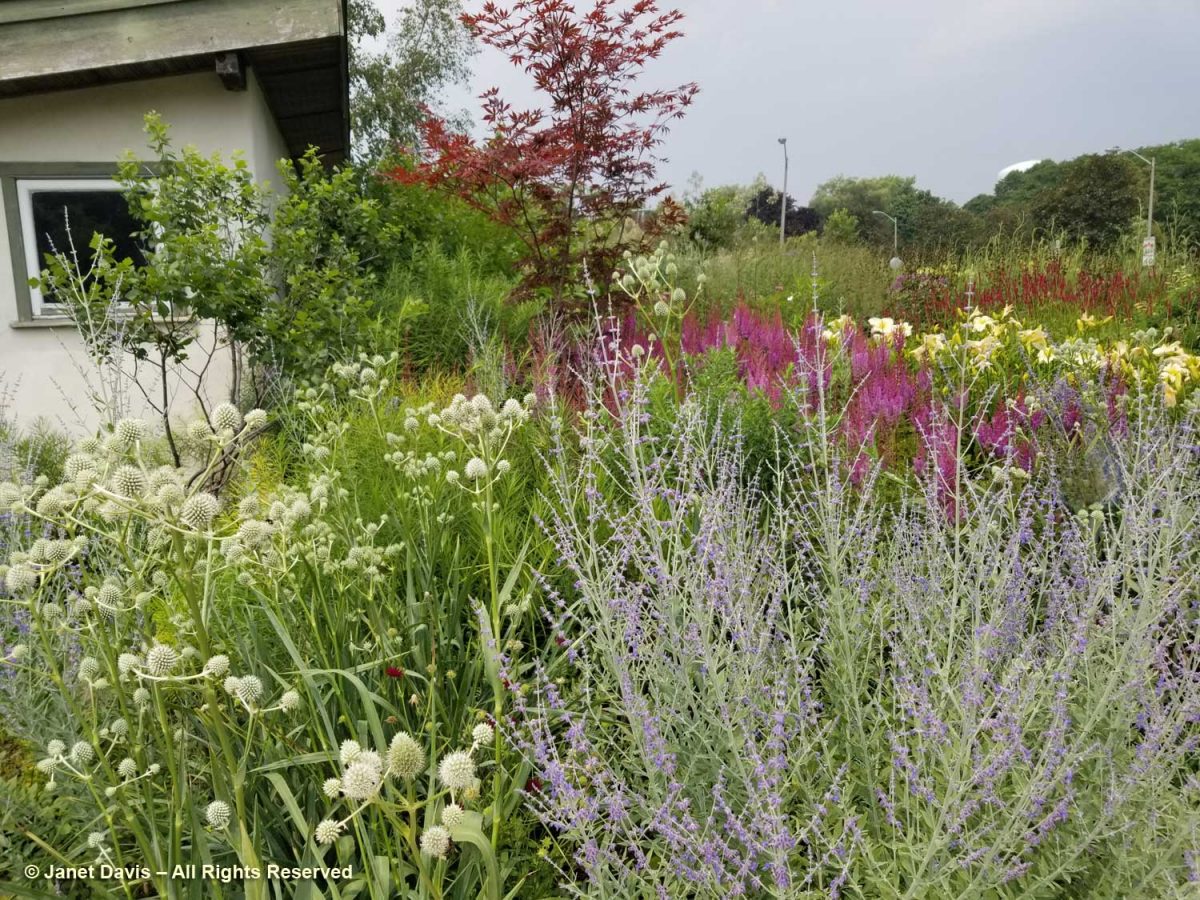
….. and the bees were buzzing in the blazing stars (Liatris spicata).
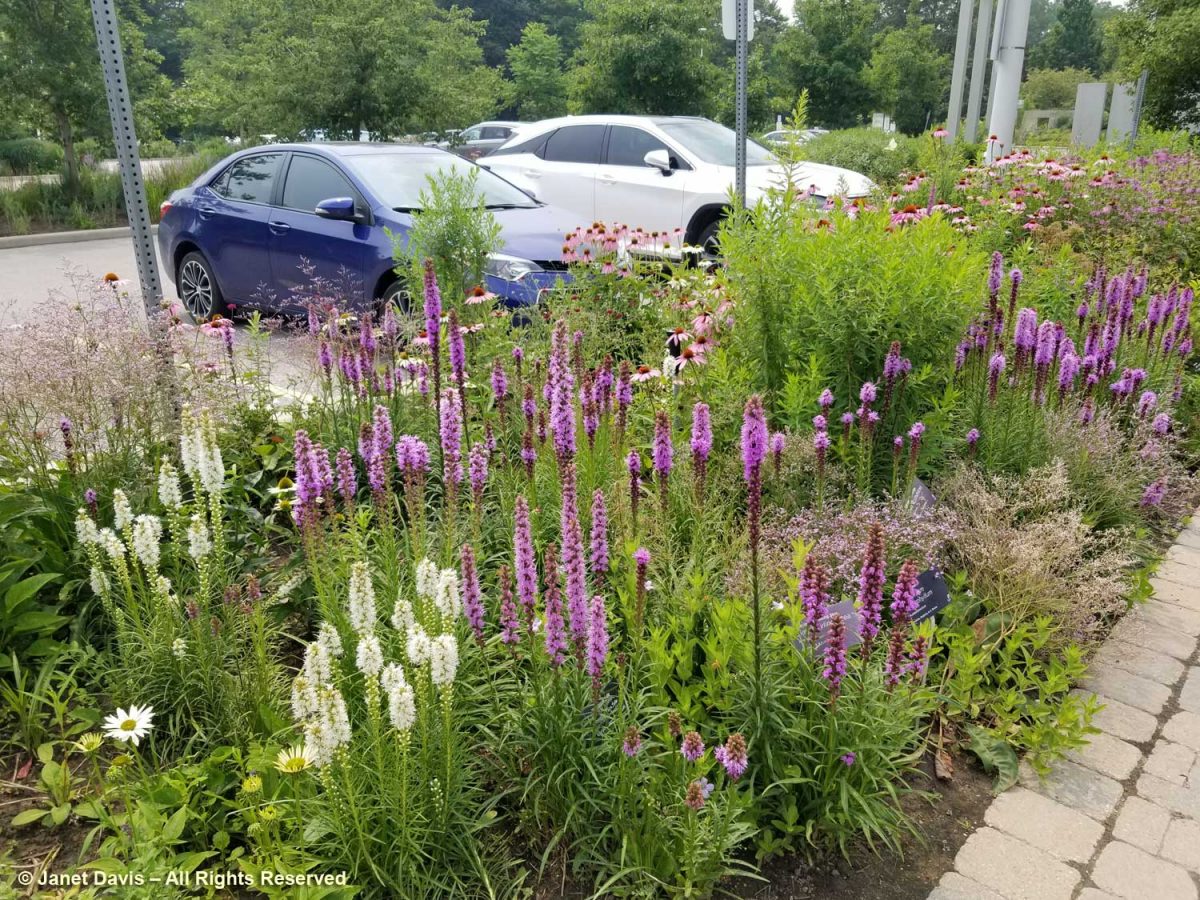
The Entry Border sported new rails to keep out unruly, selfie-snapping visitors….
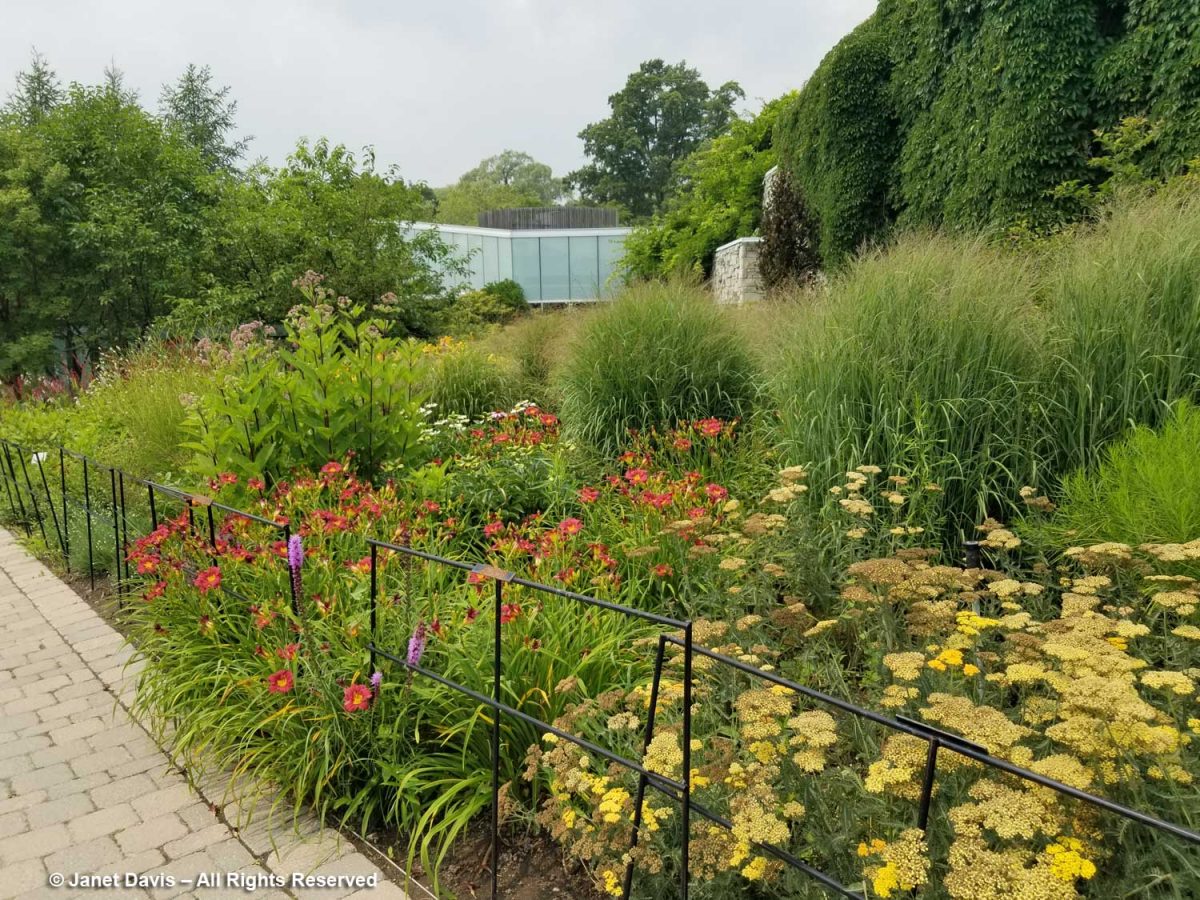
…. with a few noticeable plant additions that might not have been strictly ‘Oudolfian’, like the brilliant orange daylilies behind the rampaging Persicaria amplexicaulis ‘Firedance’, below As I wrote in my 2-part, 2017 blog on the design of the border, Piet Oudolf-Meadow Maker–Part 1 and Part 2, the border was funded by the Garden Club of Toronto and constructed in 2006. Piet Oudolf recommended a full-time gardener as part of the ongoing maintenance of the entry garden. In his work with Chicago’s Lurie Garden (read my blog on the Lurie here), there was a multi-year ongoing relationship between him and the Lurie’s gardeners; that did not happen at the TBG due to financial constraints The complexity of this garden, its self-seeding plants and the ongoing assessment of performance stretches the capacity of a severely underfunded garden (I’ll get to that later, too).
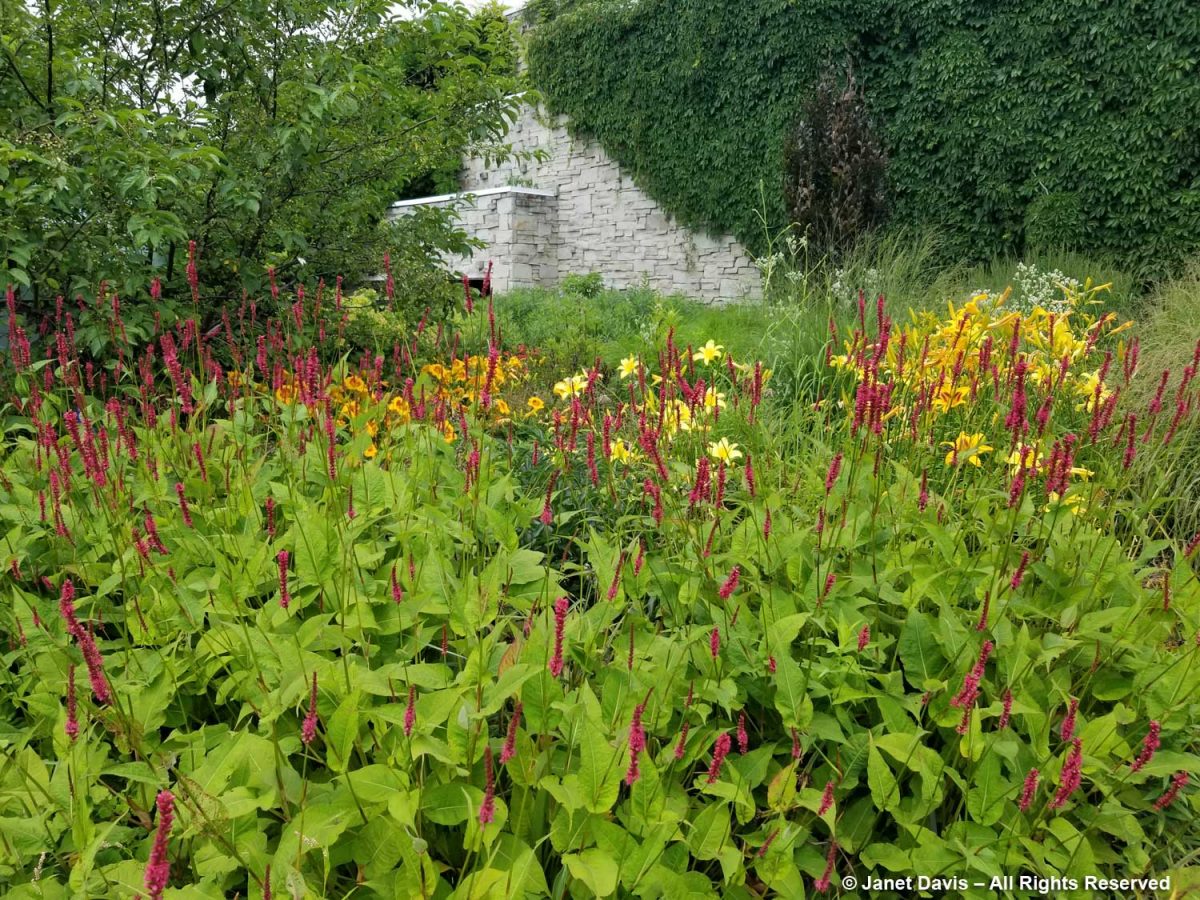
However, when I rounded the corner from the entry border to the entrance courtyard itself, I was dismayed. Red and blue salvias in Victorian ribbon planting with canna lilies. It felt a little like being in a 1950s municipal park.
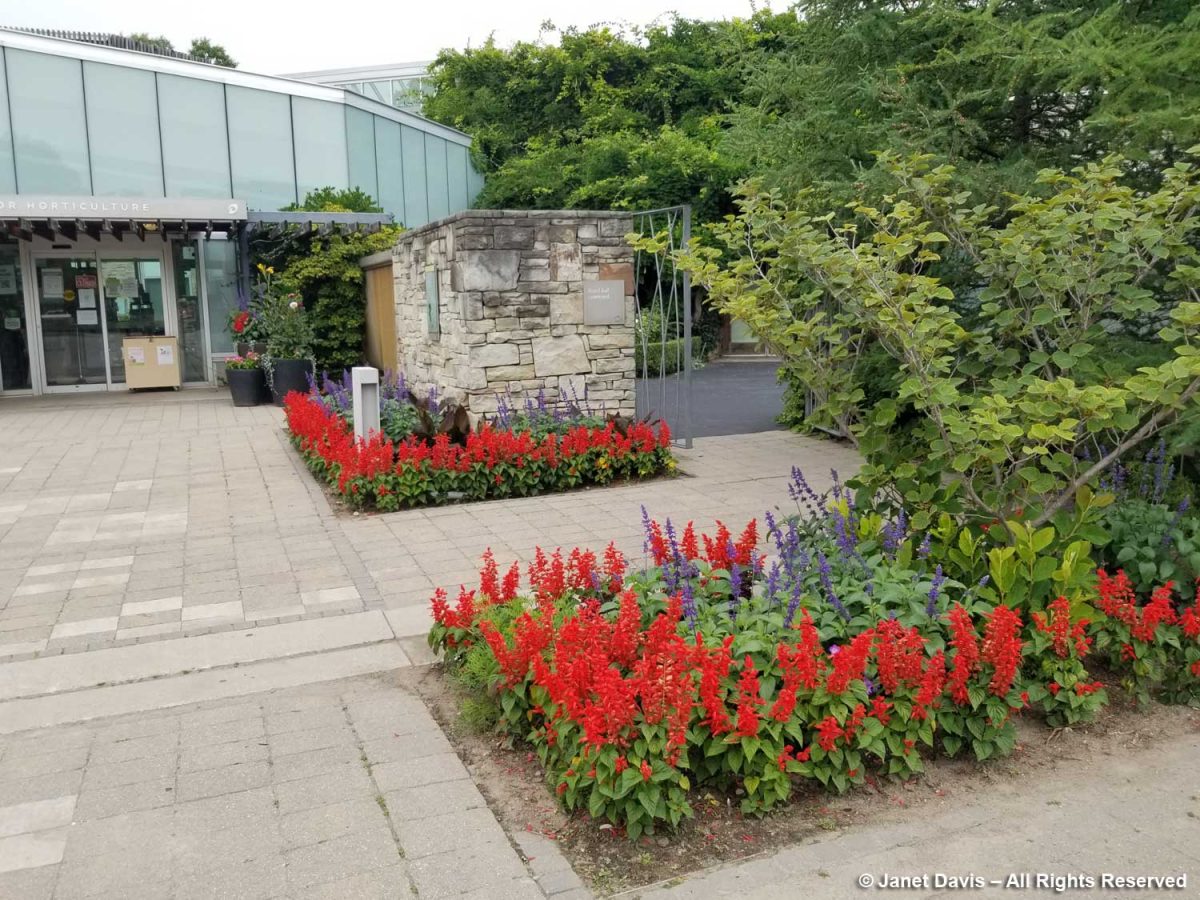
What happened to the creativity that should be the hallmark of a botanical garden, even in the current straitened circumstances? The little square near the entrance is prime real estate, intended to be the greeting card for all who come to the TBG. In spring, it always hosts a colourful mix of bulbs; later swishing grasses and interesting annuals and biennals. But this?
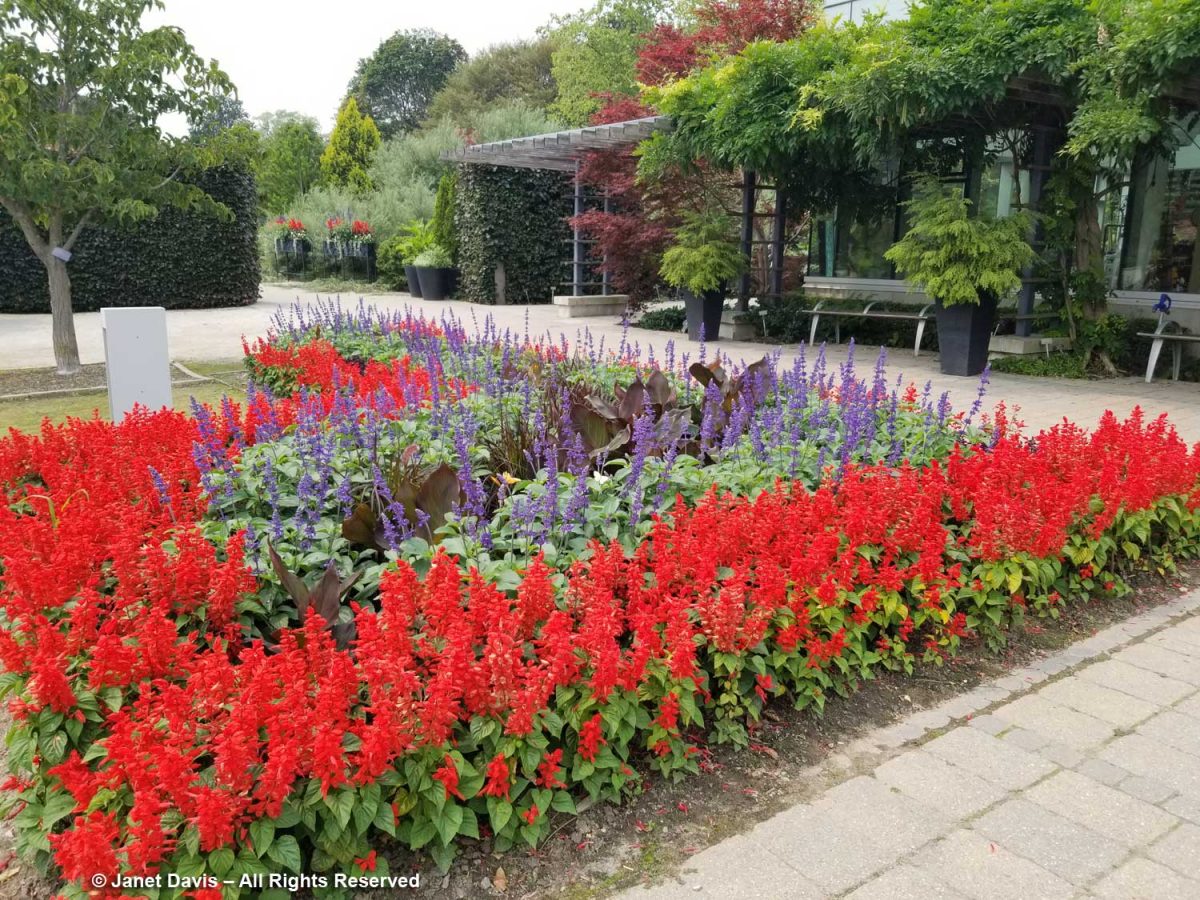
These urns used to be filled with wonderful annuals and tropicals…
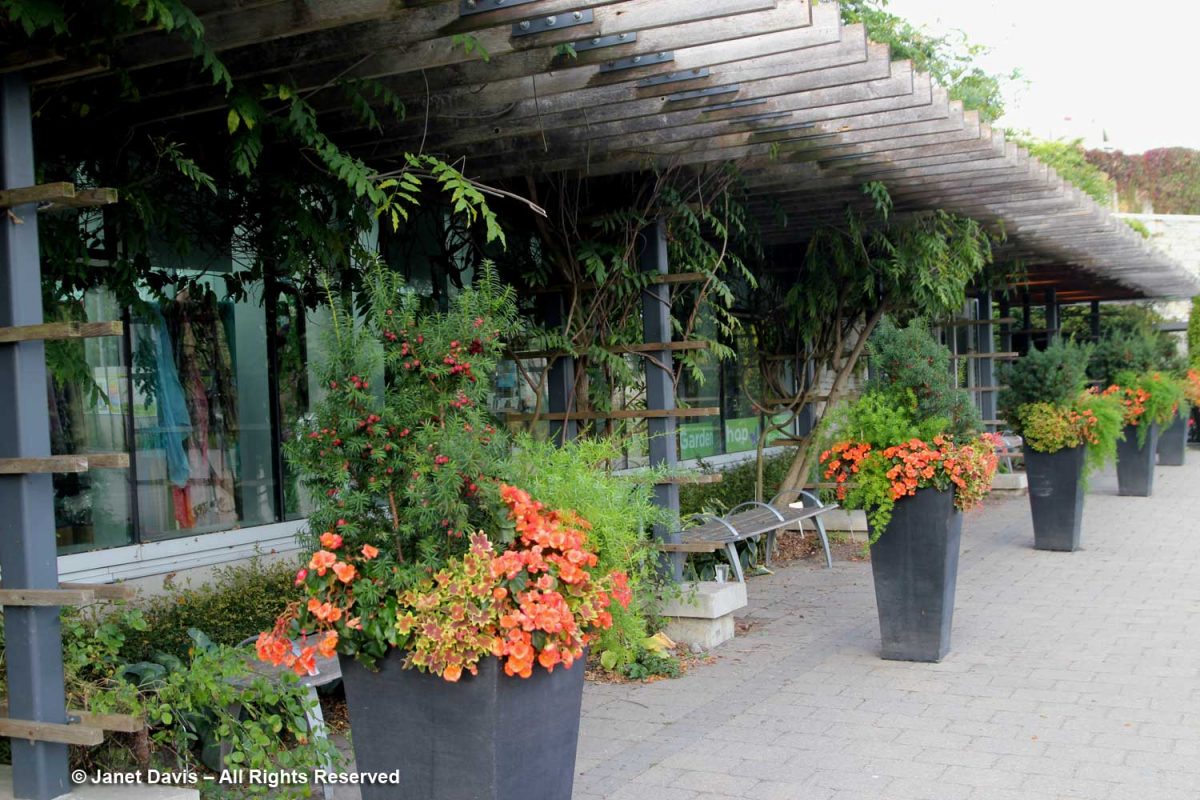
…now they’re filled with dwarf hemlocks. Just plain hemlocks.
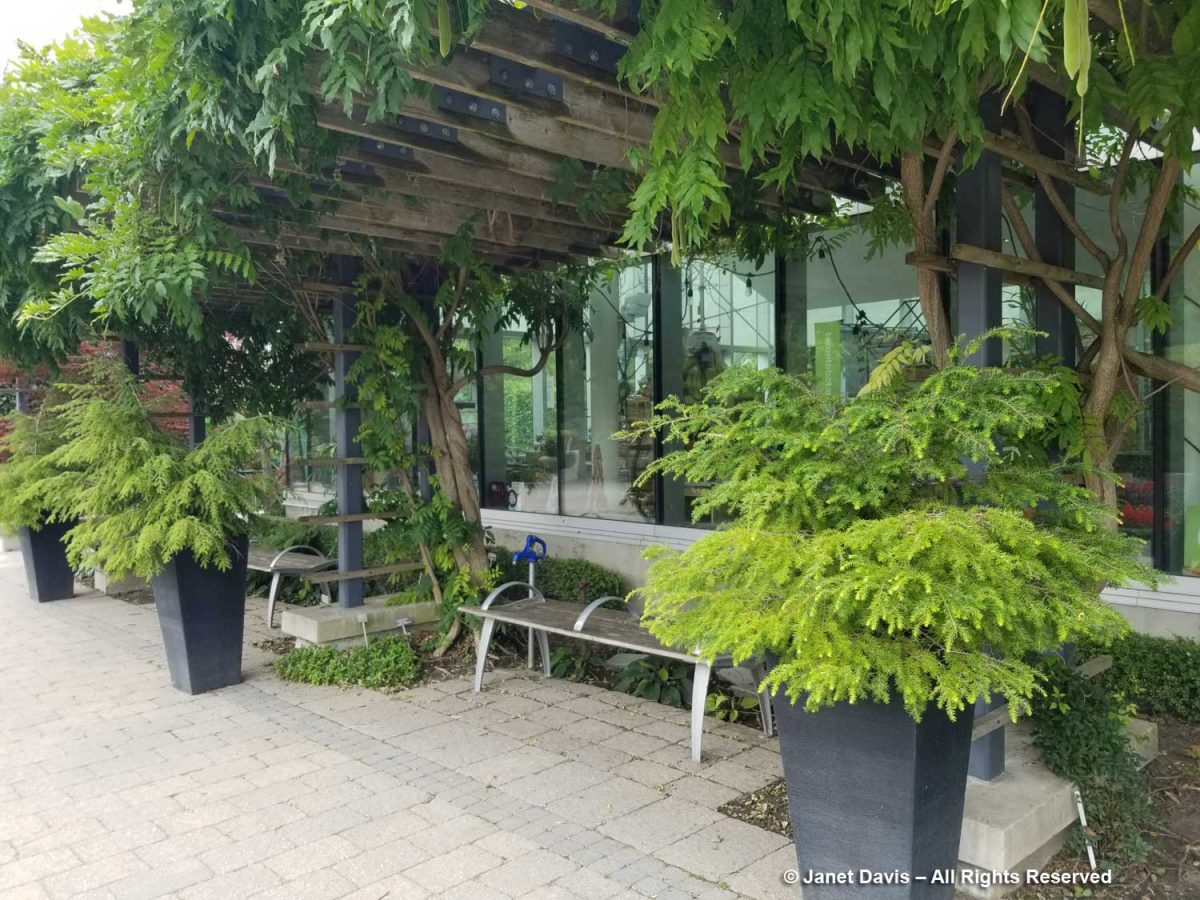
Around the corner in the garden flanking the water channel in the Westview Terrace, there were impatiens plants sprinkled throughout the perennials. Given the prevalence of devastating IDM (Impatiens Downy Mildew) over the past decade, it was a shock to see them. But it was also disappointing from a creative point of view to have your grandmother’s impatiens in what should be an inspiring border filled with high performance perennials.
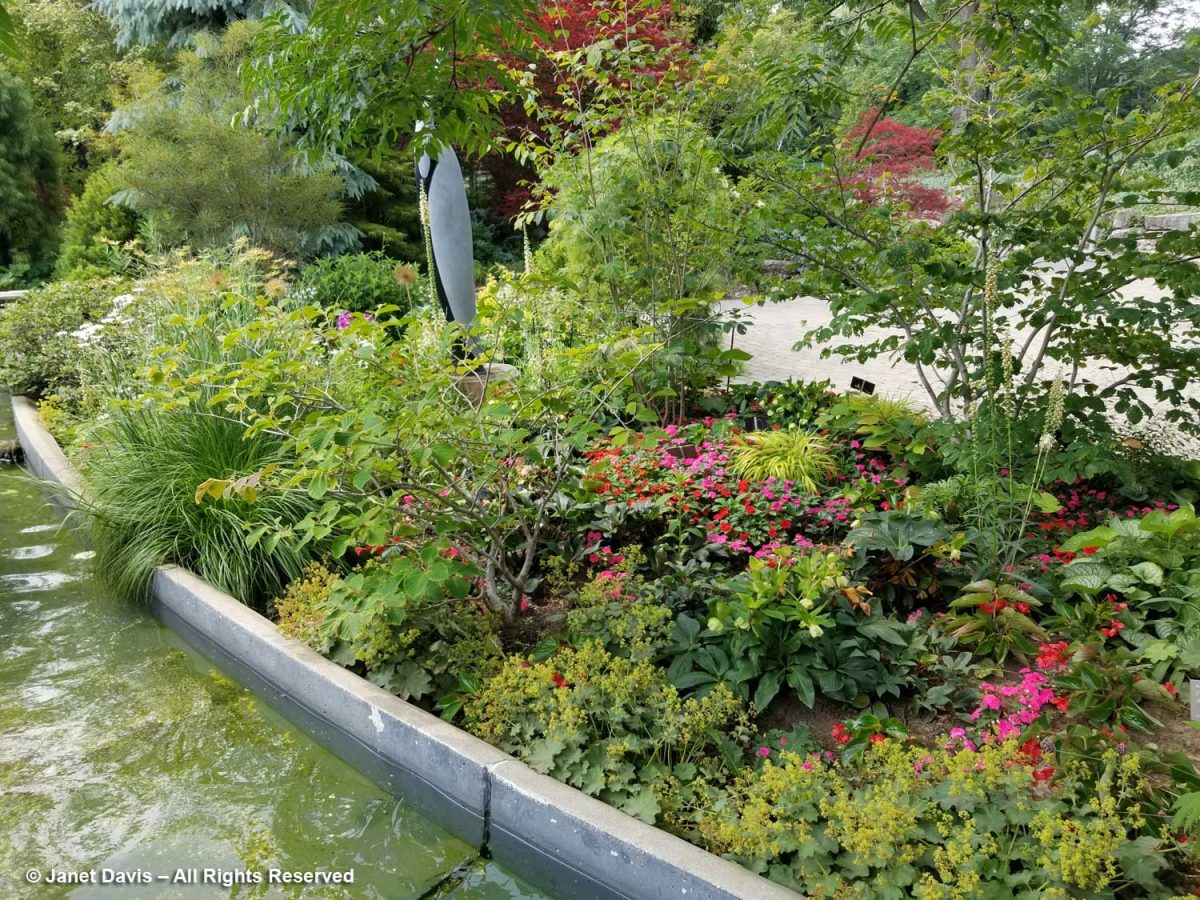
And my spirits sagged further when I walked into the Edibles Garden – or what used to be the productive, instructive, nutritious Edibles Garden – to find it filled with bedding annuals in a new Trial Garden. The “Wild for Bees” installation would not be seeing a lot of activity with the annuals chosen here.
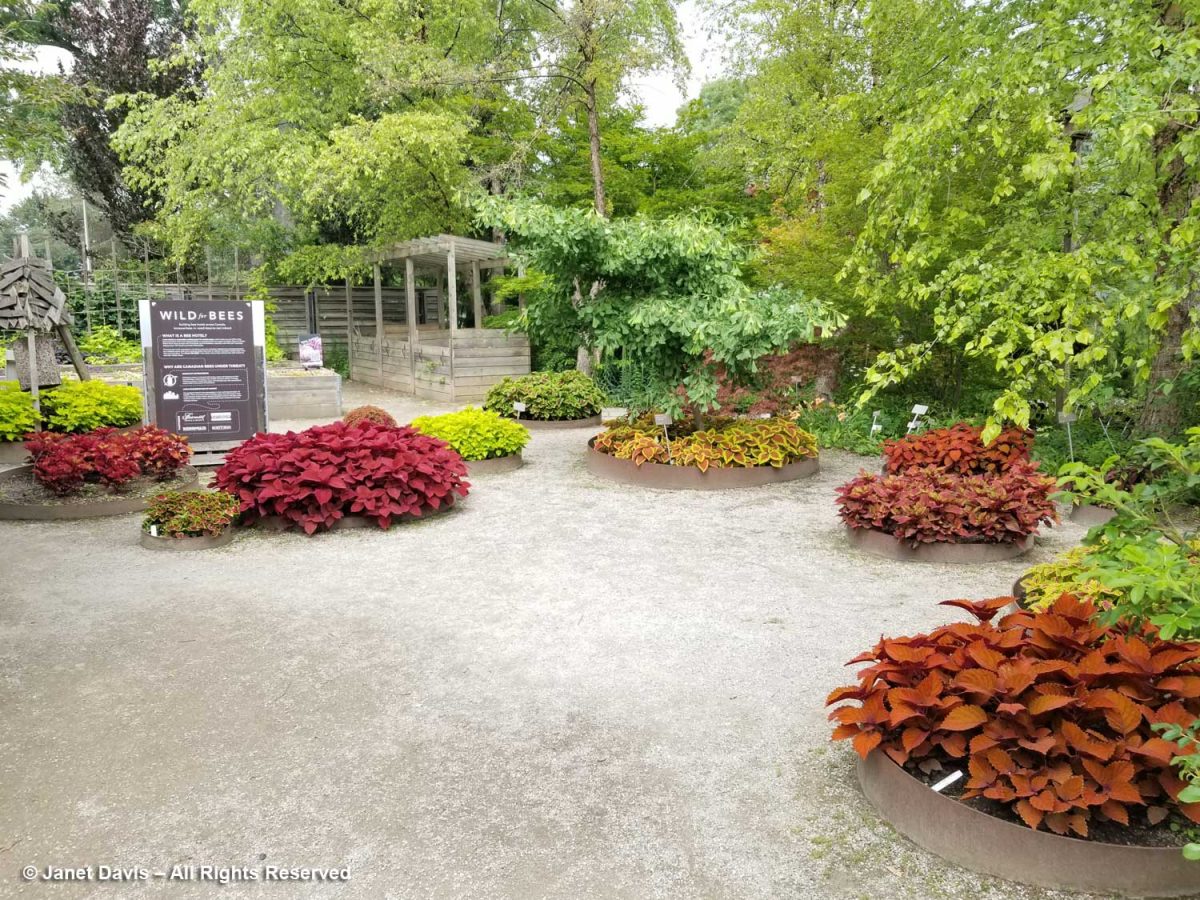
I know Ball Flora well; I’ve been to their display gardens outside Chicago as part of a bloggers’ tour. They do good work and I’m sure they’re happy to be featured here and make it an attractive partnership, financially speaking, for the TBG. But expanses of annuals are really not showing off what should be cutting edge planting design for a garden like ours.
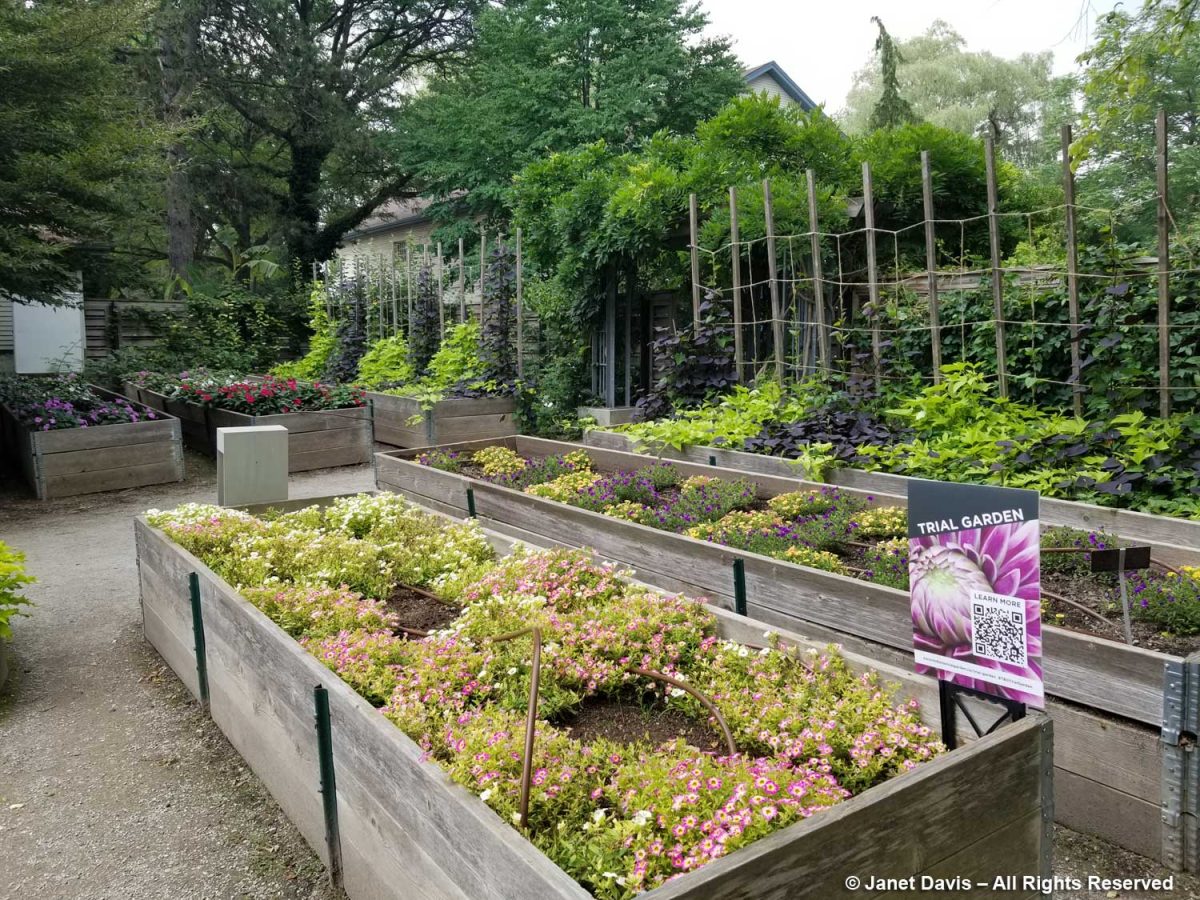
Not to mention that the Edibles Garden as it was conceived was a source of hundreds of pounds of annual donations to the North York Food Bank. Here are some of my photos from previous years. This was 2014.
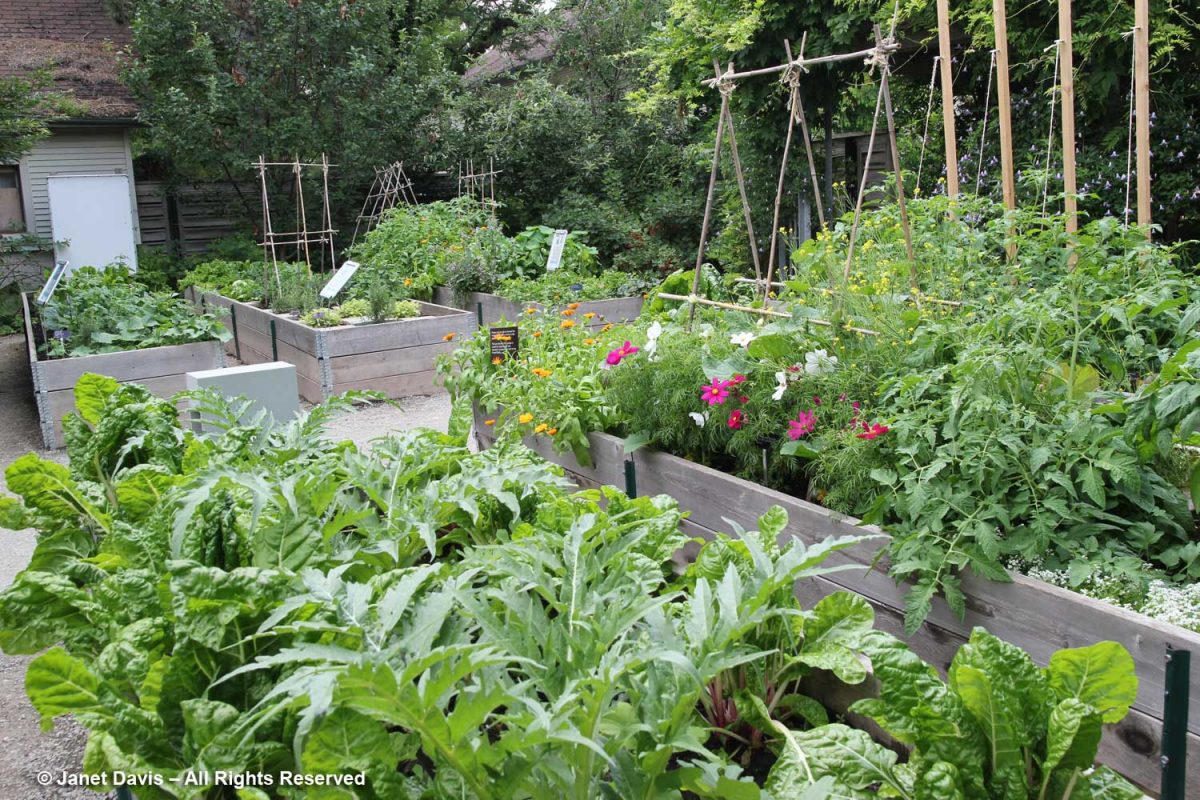
And 2016’s edibles.
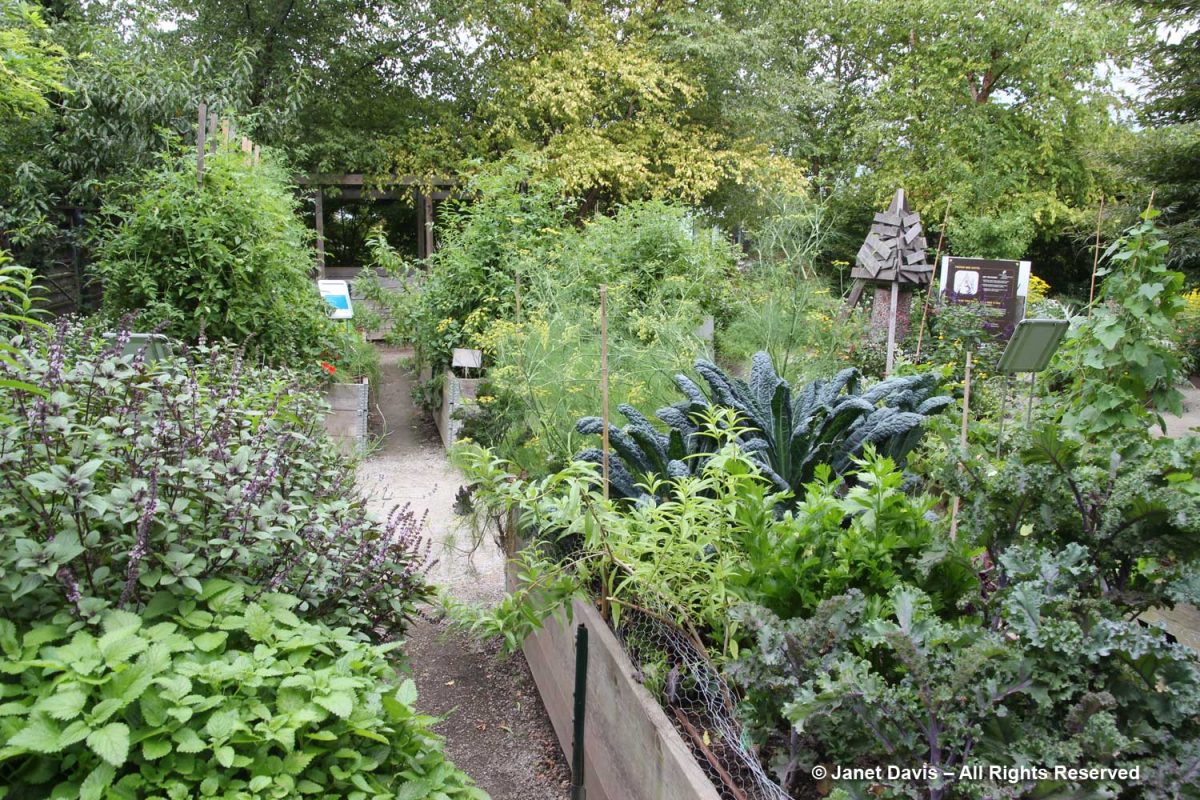
A visitor from Victoria looked quizzical. When I asked what he thought, he said “They seem to be growing very common plants here.” Indeed. Instead of lantanas and petunias, what about a garden of fragrance in front of this hedge, with lilies, nicotiana, dianthus, scented peonies, heliotrope, phlox, dwarf lilac, daphne, hyacinths, clethra, etc? The TBG is light on small ‘theme gardens’ that help people design their own spaces
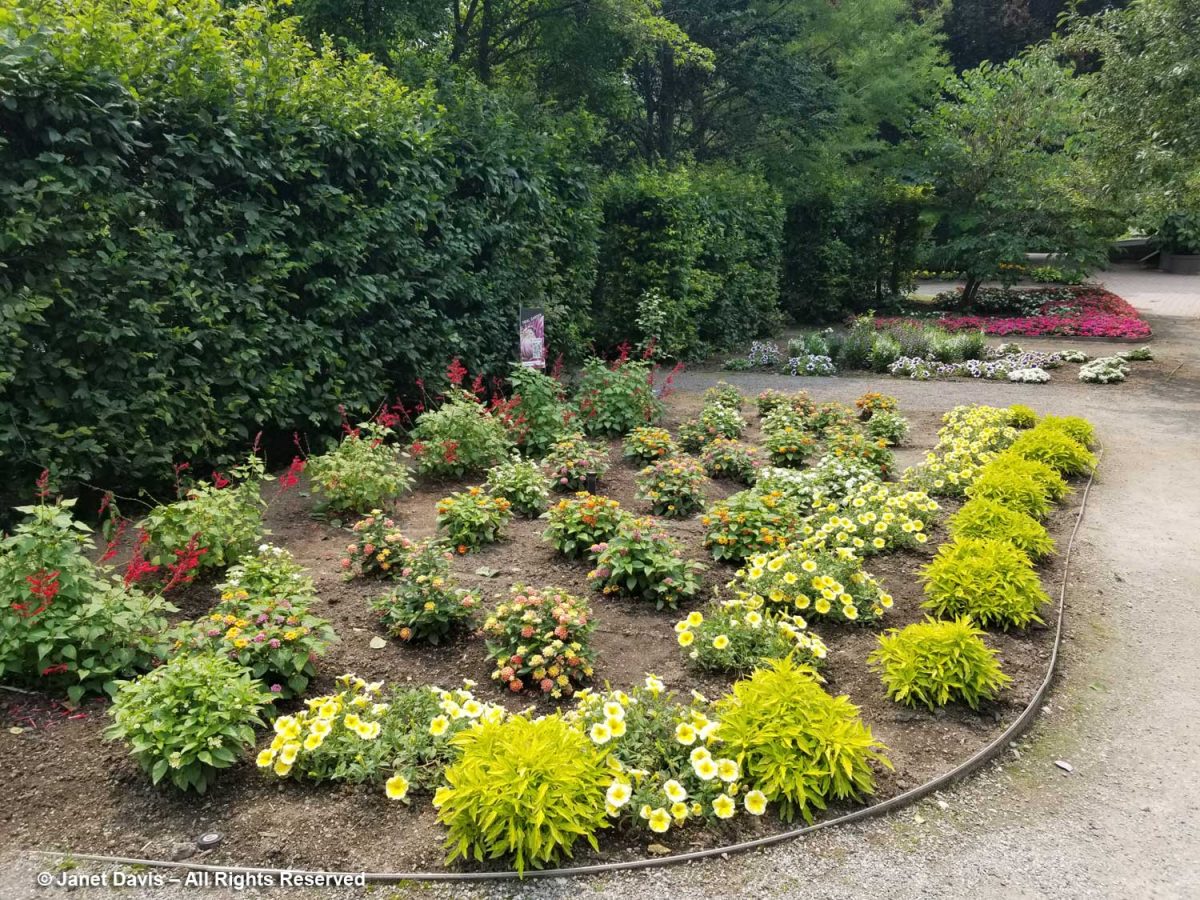
A bed in the Beryl Ivey Knot Garden had been planted bizarrely with Scotch thistle (Onopordum acanthium), which is as invasive a self-seeder as it is gawky. Why it would be plunked in this formal space is beyond me.
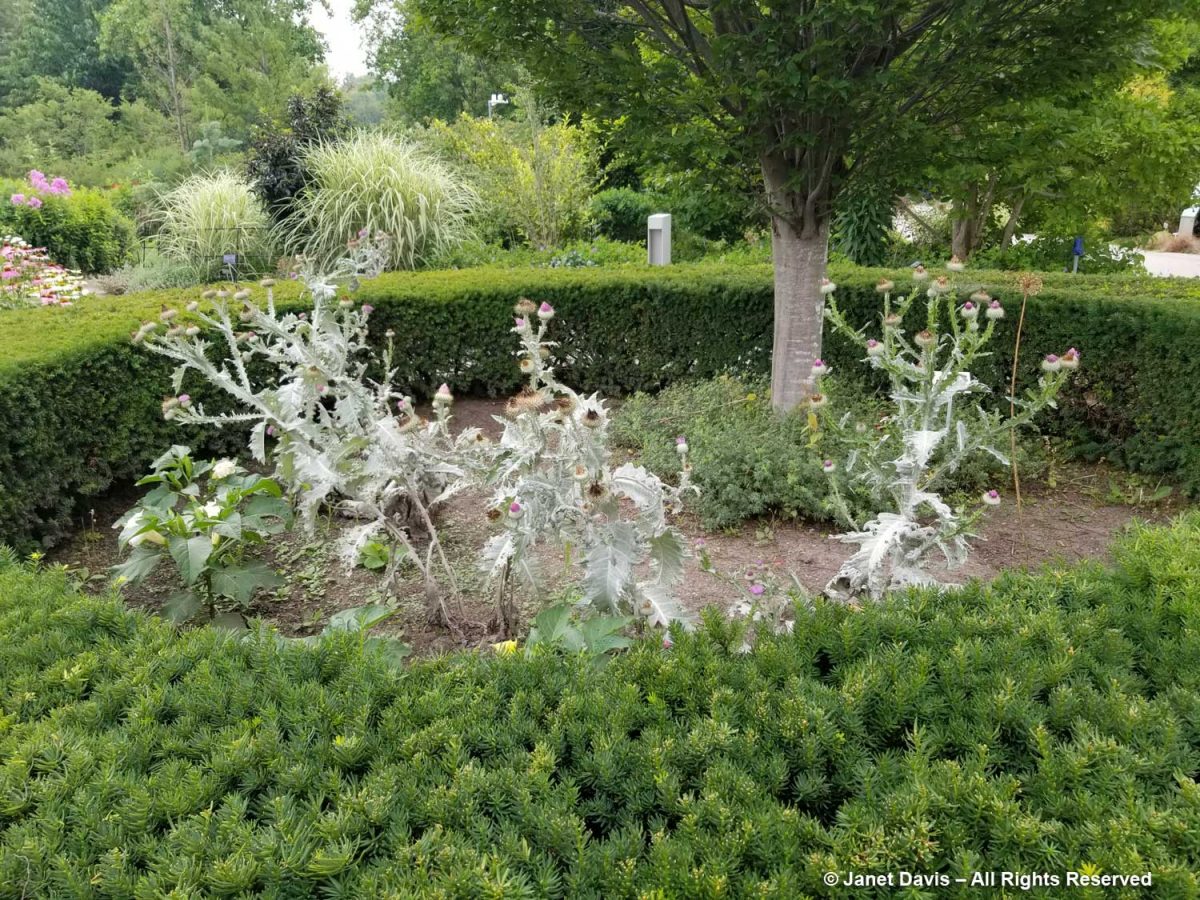
When I walked towards the perennial borders, I passed the window-box planters adjacent to the Spiral Garden. There must have been left-over red and blue salvia because these looked pedestrian, too.
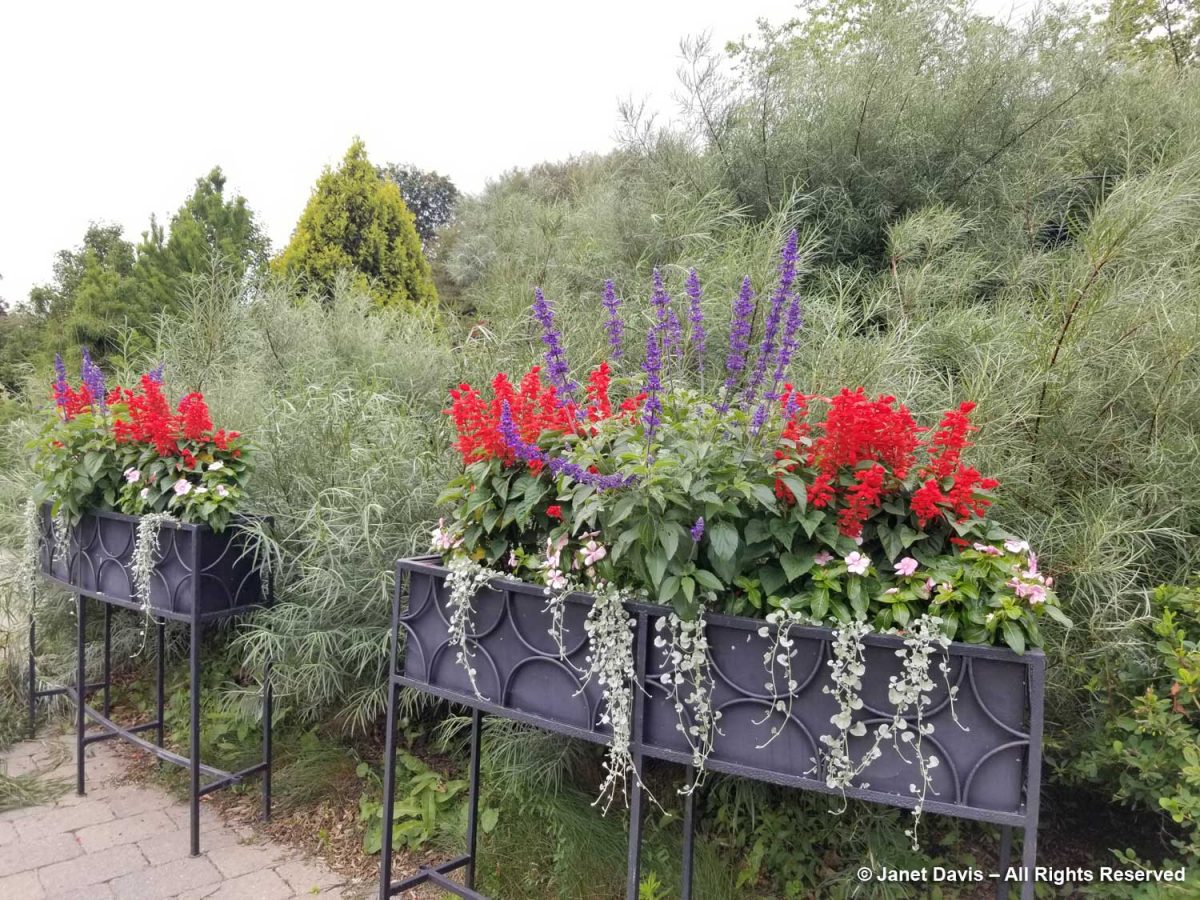
In 2016, I wrote a blog on the TBG’s planter designs featuring the great creativity of the garden’s previous horticulturist Paul Zammit. The photo below shows three years of designs in these planters.
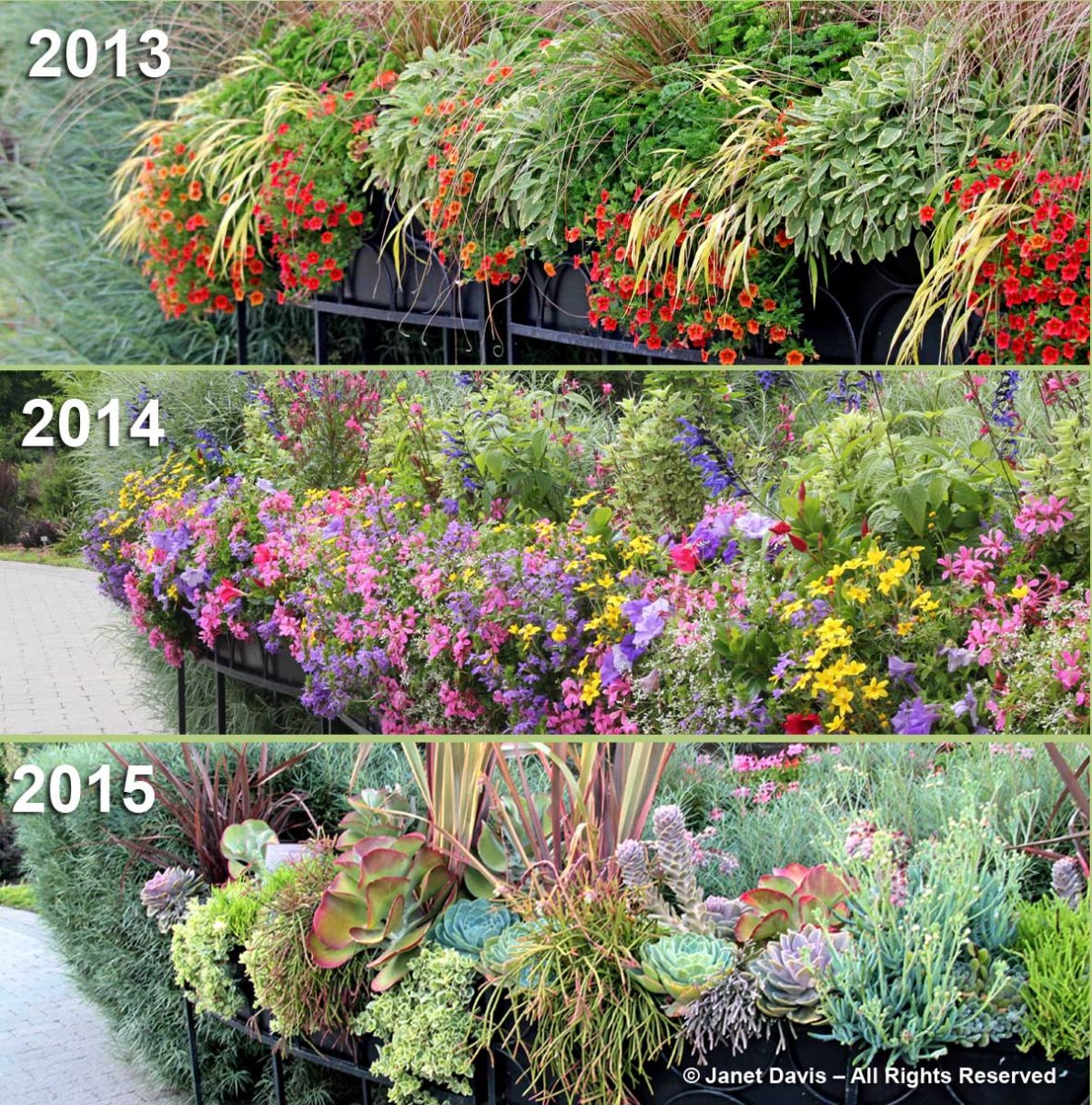
Sadly, through a lack of funding and administrative support, the TBG lost the creative minds of both the previous chief horticulturists, Paul Zammit and Paul Gellatly. My purpose here is not to retread the institutional woes, exacerbated greatly by Covid, that led to the May 22nd Globe & Mail story. It is to reflect on what made the garden brilliant as an underfunded 4-acre jewel and what looms ahead as a major 35-acre botanical garden (final concept plan below), once the merger with Edwards Gardens is complete.
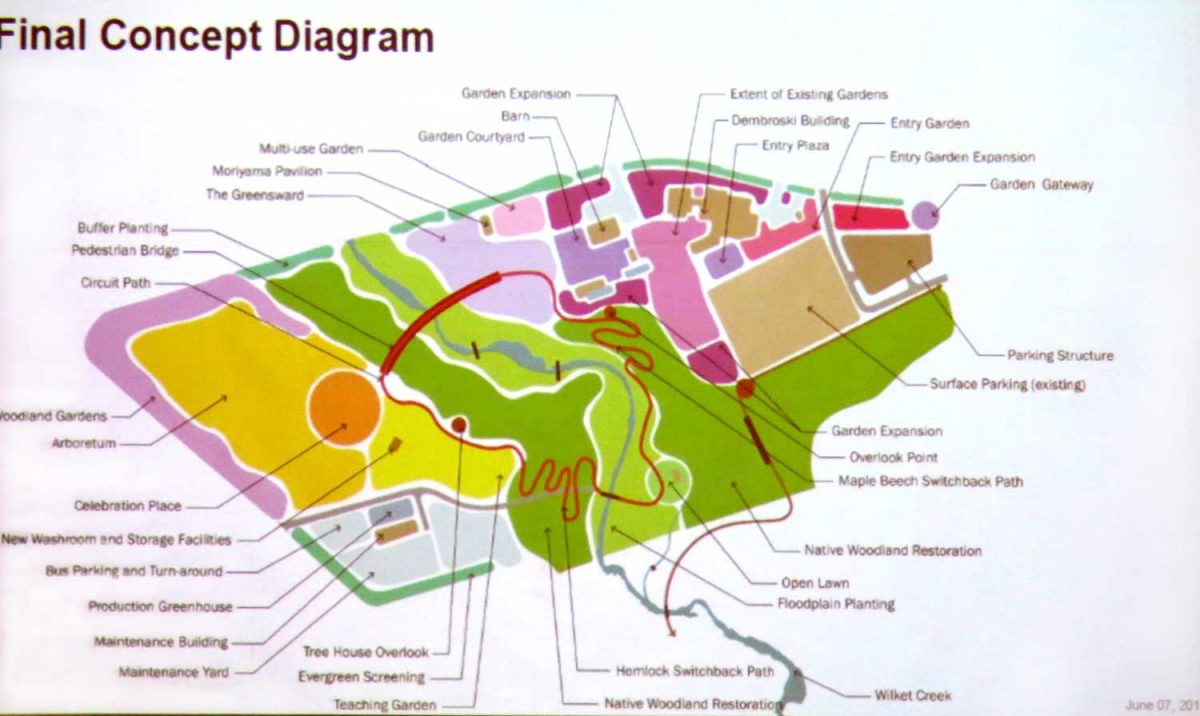
On that note, I attended all three community engagement meetings with landscape architects and city planners, so I know a little of what went into the planning of the new garden, as spearheaded skilfully by former Executive Director Harry Jongerden with creative input by landscape architect W. Gary Smith, below, pointing out details on the screen.
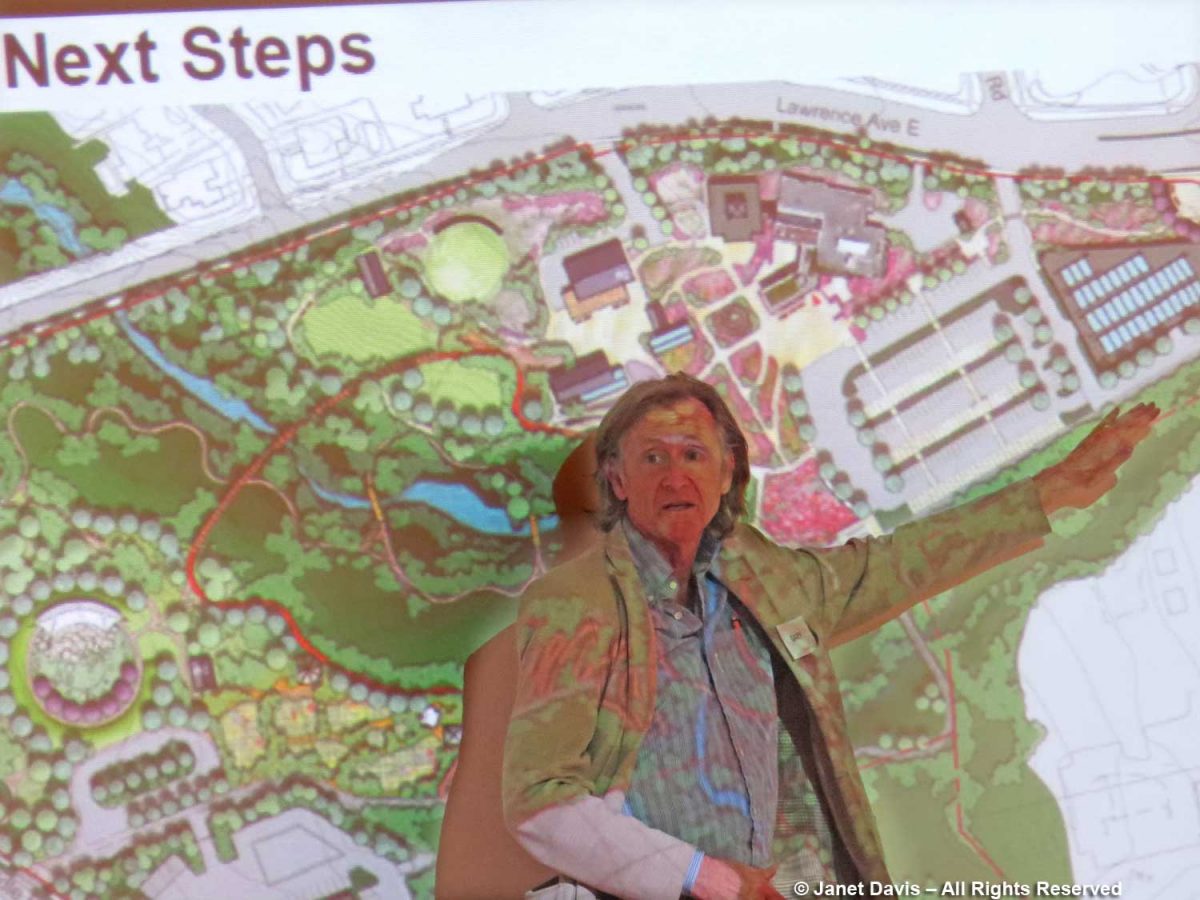
I care very much about the garden. As well as being a long-time member of the TBG and the Civic Garden Centre before that, I have written many blogs about it: the spring tulip extravaganza; the Blossom Party; the Woman-to-Woman luncheon; the annual Through the Garden Gate Tour, and more. Since May 2007, I tallied 152 visits to photograph the garden; these provided me with the images for the seasonal photo gallery that was on the TBG’s website for several years….
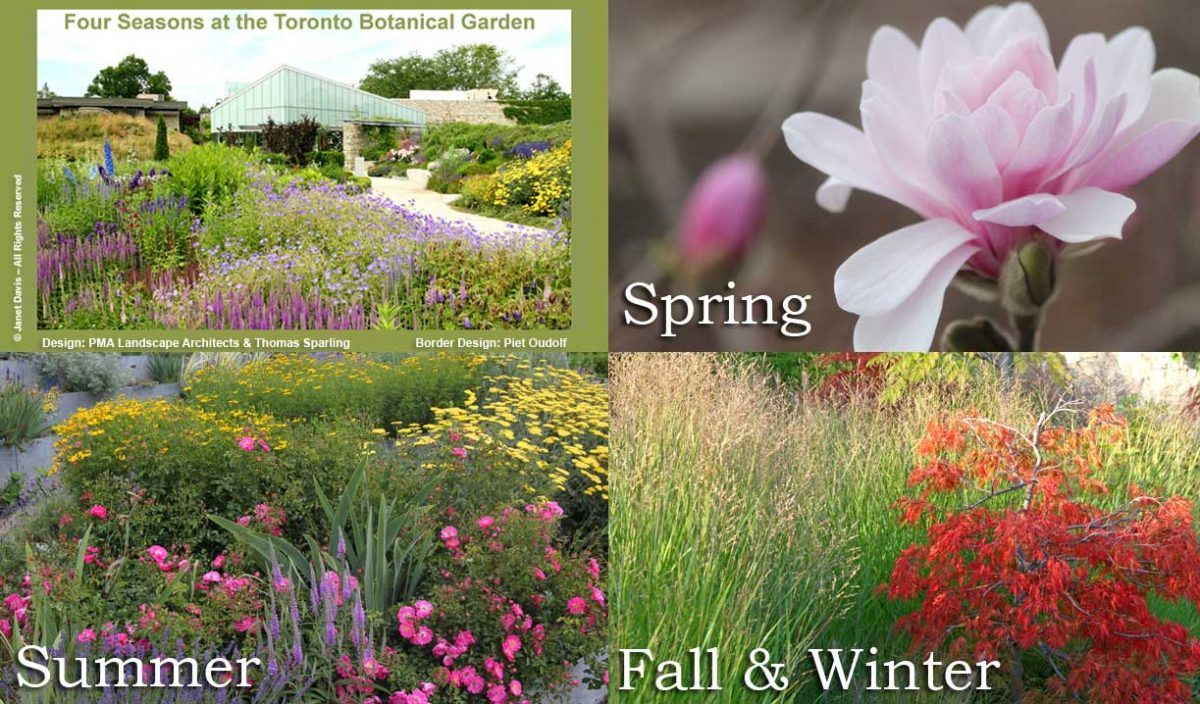
……as well as for my blogs and images the garden needed from time to time. Below is garden philanthropist Kathy Dembroski at the 2018 luncheon; she and her husband George Dembroski….
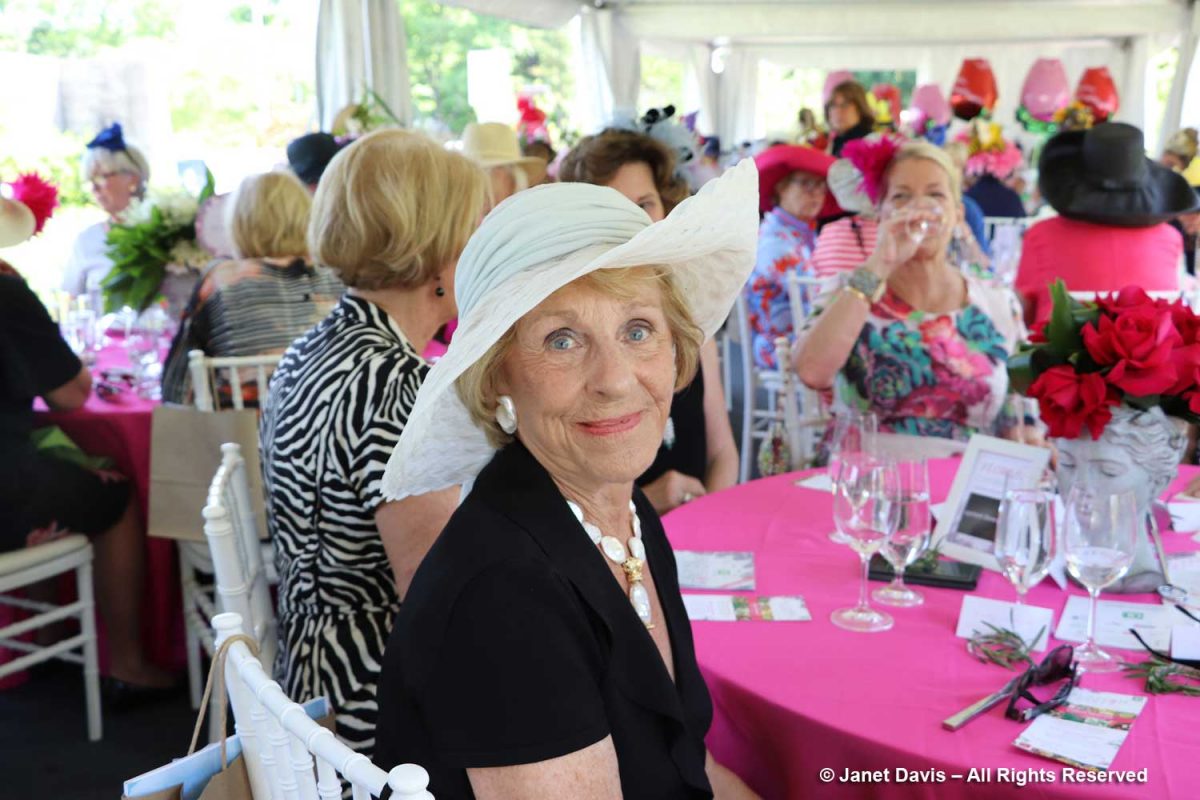
….were the lead donors for the award-winning Silver LEED building opened in their name, The George and Kathy Dembroski Centre for Horticulture.
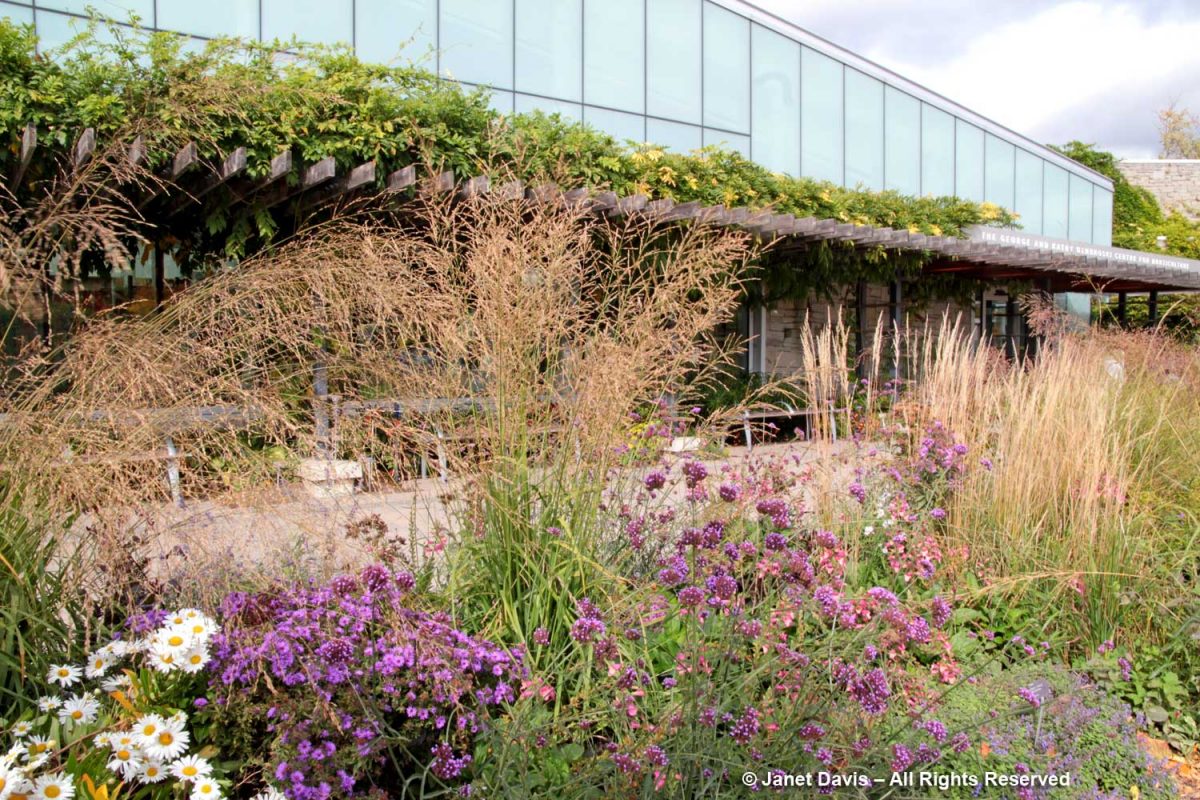
In my 33-year career as a freelance garden writer and photographer, I’ve also visited and written about a vast number of public botanic gardens, from New York, below, to Chicago, Cape Town’s Kirstenbosch, Christchurch, Kew Gardens, Los Angeles, Malaysia, Saigon and Kyoto, as well as favourite Vancouver gardens like VanDusen and UBC Botanical, among many others. I’ve also spent a lot of time in privately-funded public gardens like Chanticleer near Philadelphia and Wave Hill in the Bronx and at the iconic High Line in New York City. So I am very familiar with a broad variety of public gardens, large and small.
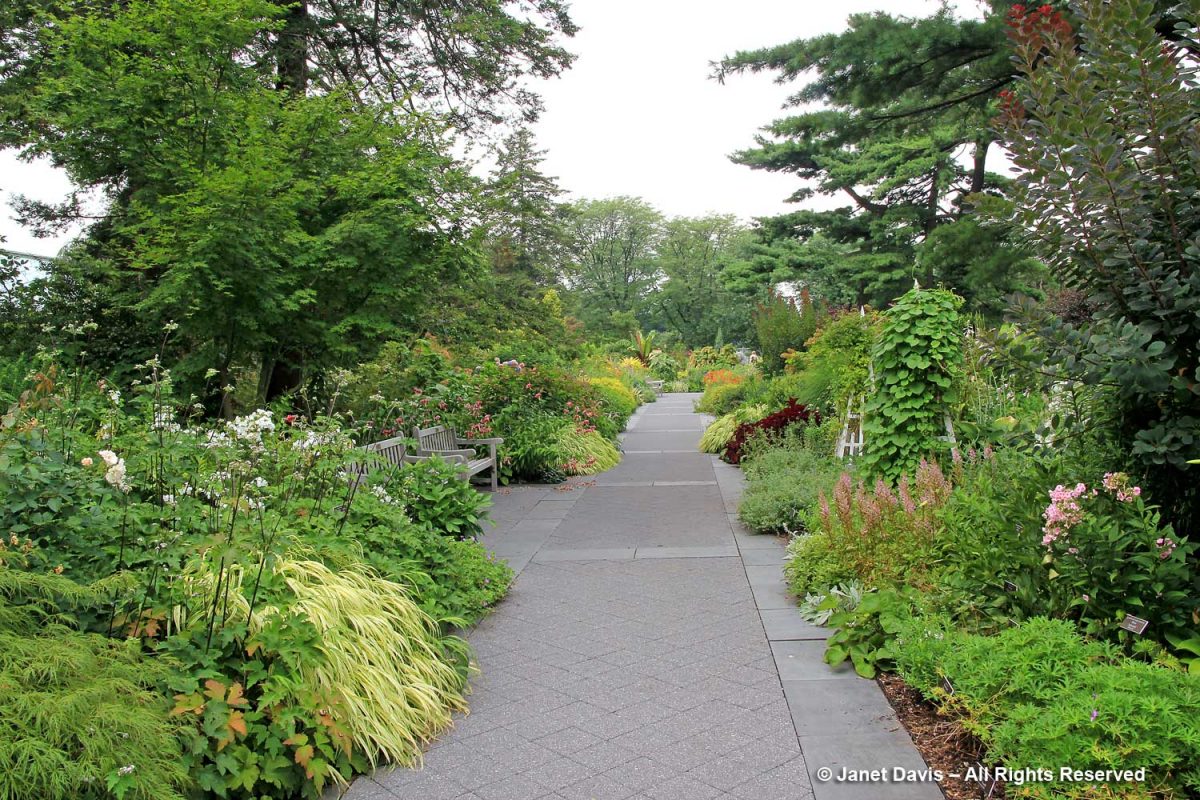
My husband Doug and I have been regular TBG donors for many years. As well, I have contributed various articles and donated photos to the Trellis magazine (my cover story on cottage gardening, below).

Our daughter was married at the TBG in October 2012, and we have beautiful memories of that showery autumn day.
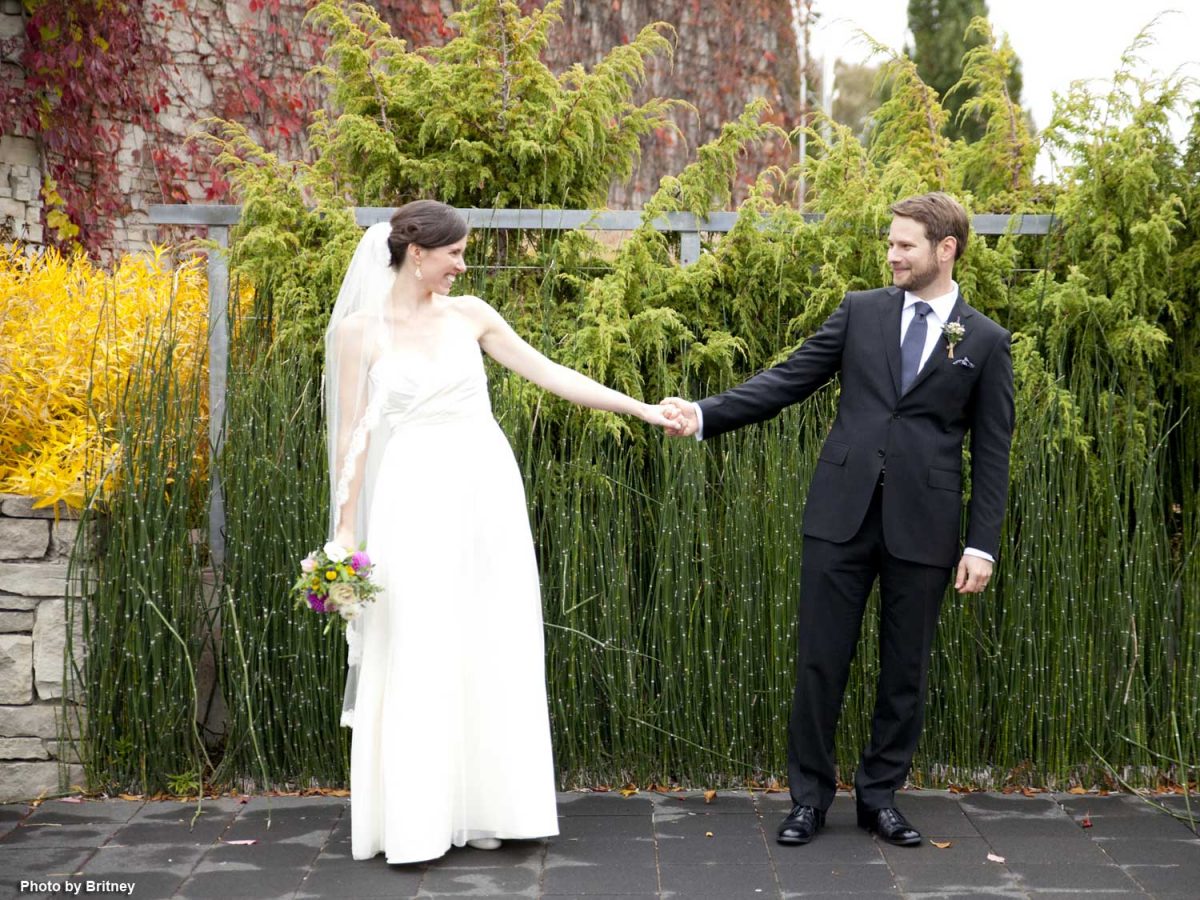
I especially loved seeing Meredith and her attendants standing in front of the donor panels featuring my own fern photos. Our rental of the facility nine years ago tallied $5,700 for her wedding, so I know how devastating 16 months of Covid closure has been for TBG rental revenues….
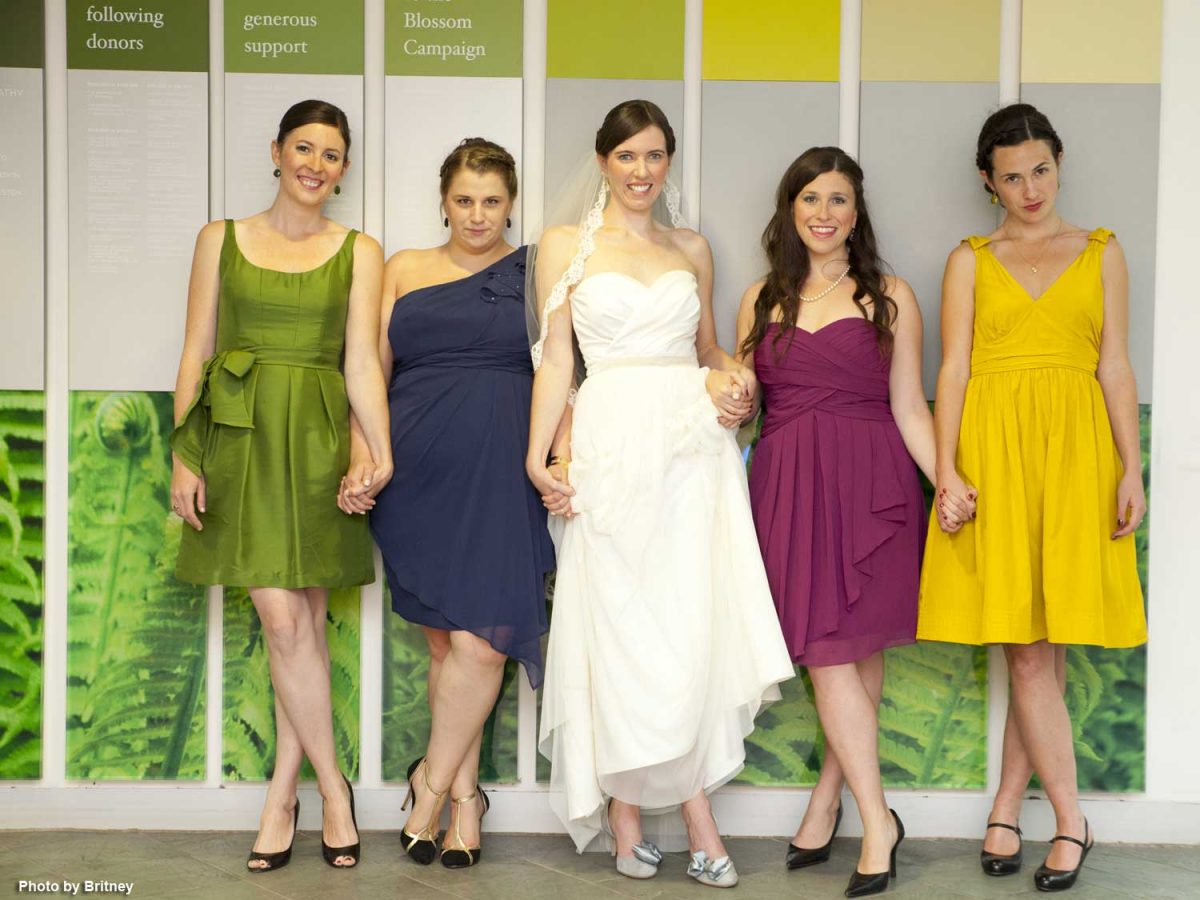
….. not to mention the loss of sales from two consecutive annual plant sales and the summer fundraiser garden tour.
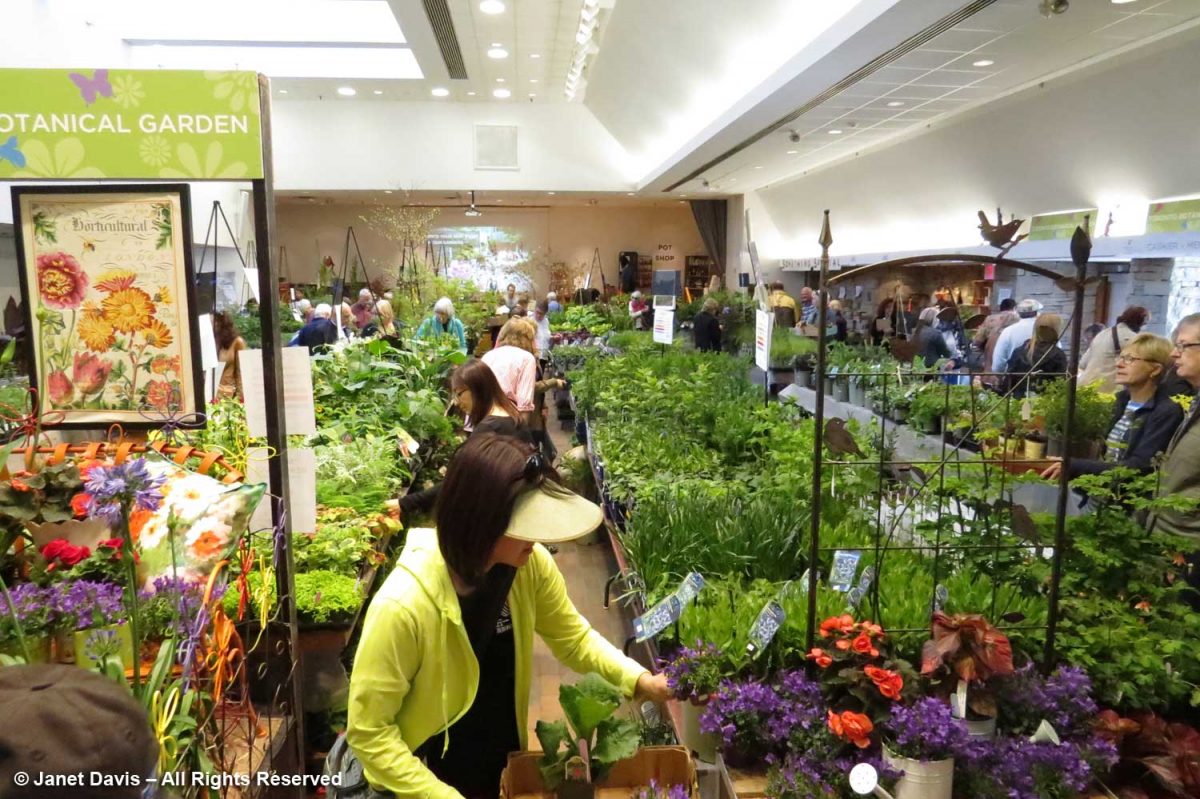
*******
Why am I writing this blog? It’s not to trumpet my work in gardening, but to share a concern I have. Following the TBG’s Annual General Meeting in June – an online meeting that painted everything as rosy and was carefully scripted to exclude any critical commentary from members upset with board decisions – acting Board Chair Gordon Ashworth encouraged members to send in any issues they might have. This is my response. In a word, it has to do with MONEY. At 35 acres, the expanded TBG will present both a great opportunity and an ongoing challenge to bring ground-breaking horticultural and environmental displays to Greater Toronto’s 6 million people, as well as providing inspired educational programs for children and adults. Ironically, the TBG’s current fiscal challenges have come at the same time as the federal and provincial governments announced a $2.2 million investment in Burlington’s Royal Botanical Gardens, below, as part of its 25-year master plan. Without taking anything away from the RBG and notwithstanding its 300 acres of gardens and 2400 acres of land stewardship, it is not positioned in the centre of the 4th largest metropolis in North America.
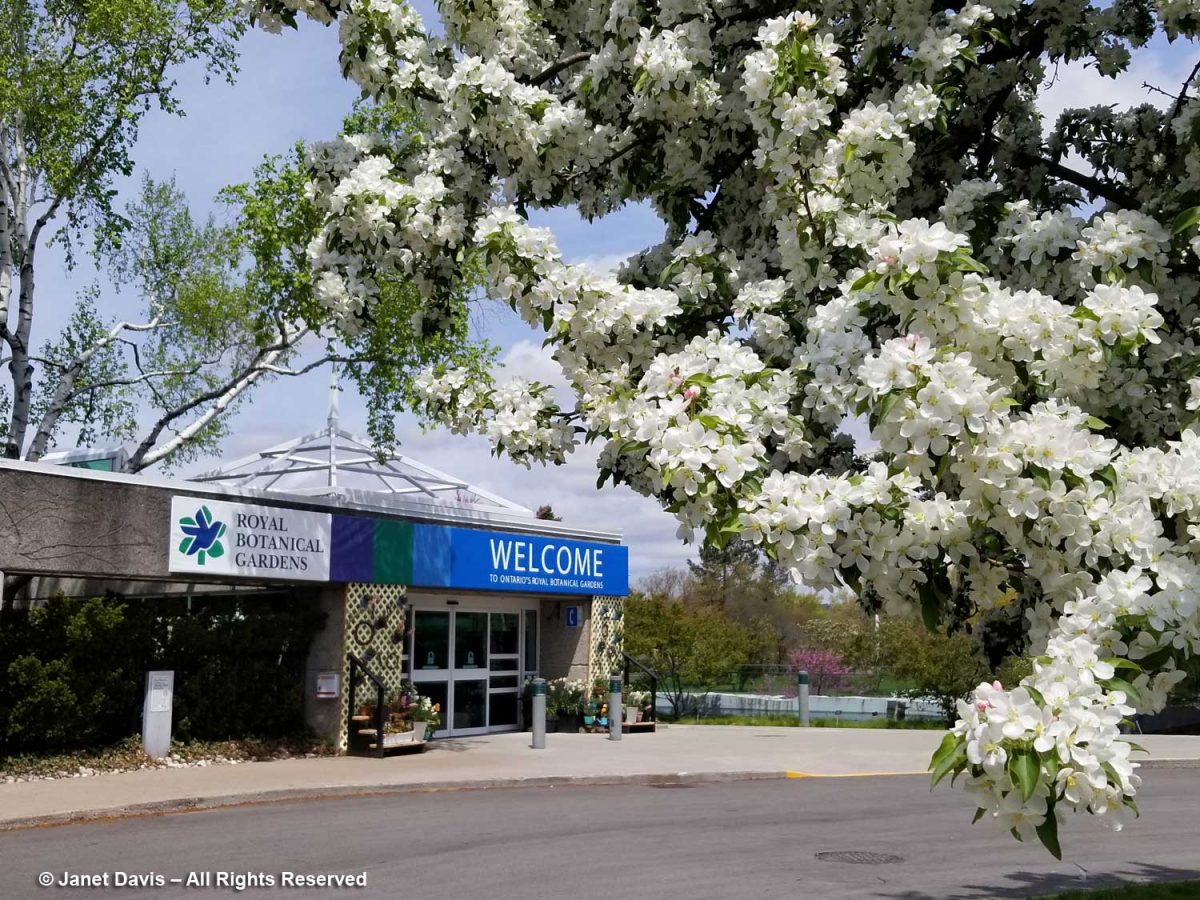
In 2012, I attended a city council meeting at City Hall to support the TBG’s then Executive Director, Aldona Satterthwaite as she begged for more financial support than the paltry $25,000 the city has traditionally given the garden in order to overcome a small deficit caused by the lack of potential revenue owing to the protracted parking lot renovation, a lot used mutually by Edwards Gardens and the TBG. I made the photo below in spring 2012; the work went on for months and months. Naturally, facilities rentals declined sharply. Through the efforts of Ward 15 City Councillor Jaye Robinson, bridge funding was secured to keep the garden solvent.
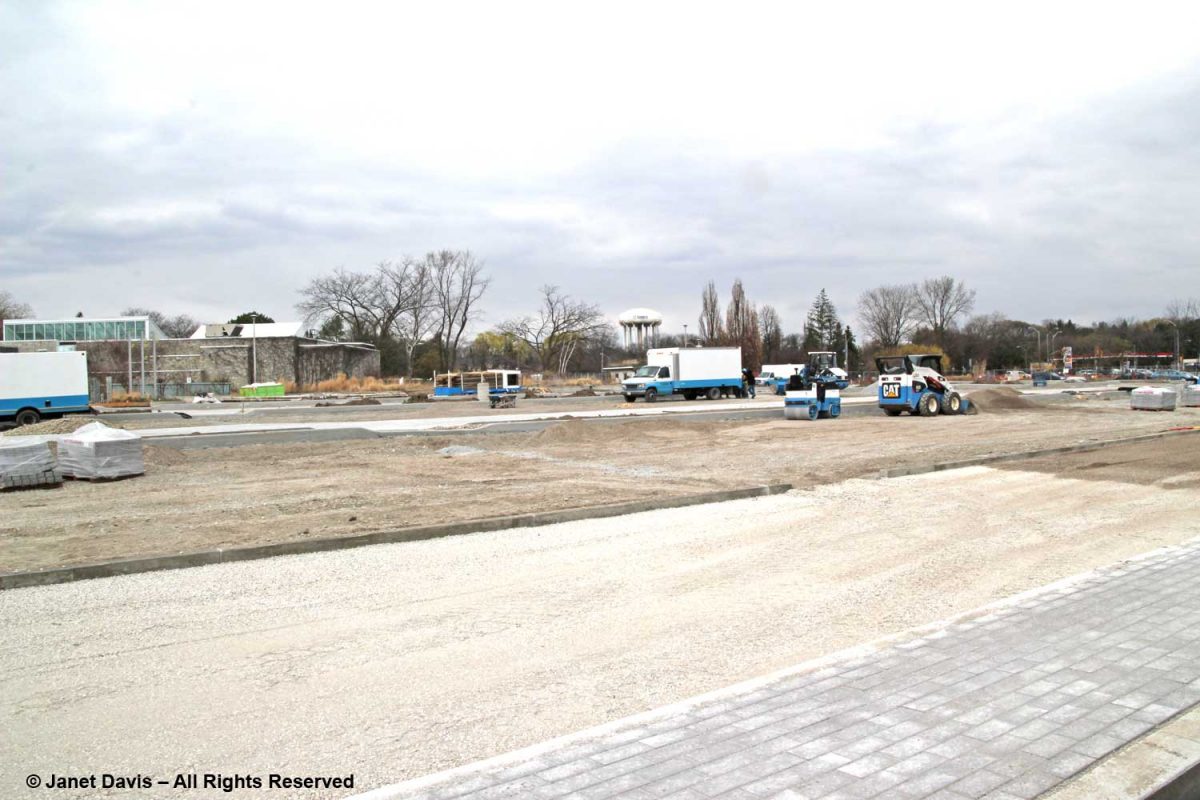
At that City Hall meeting, former Councillor Janet Davis (my doppelgänger) asked me during a scrum if I knew how much other gardens charged for admission. I answered that most had an admission fee except ours. In the case of privately-run, 55-acre Butchart Gardens in Victoria, which receives more than a million visitors annually, it is very steep, reflecting the cost of running a world-class garden (not a botanical garden, but useful for comparison). In 2013 when I photographed the entrance, below, it was $28; it’s now $36. Well-run, creative gardens cost money. It’s that simple.
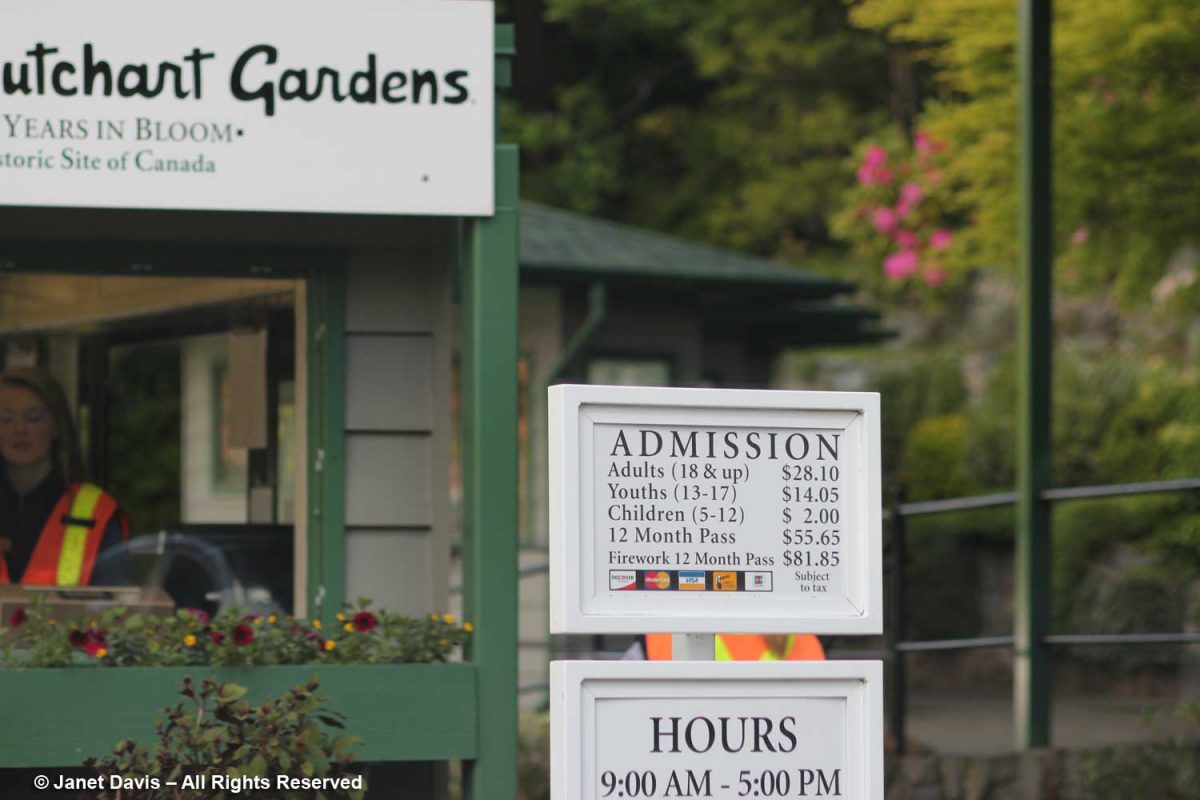
I make this point because one of the major conditions in the expansion plan between the City of Toronto and the TBG is that admission to the expanded 35-acre botanical garden be free. At first glance, this is in keeping with ‘park’ policies; you don’t pay to visit High Park or any of the city’s many excellent parks, and Edwards Gardens is a large ravine park currently accessed via the renovated parking lot whose significant parking fees now thankfully accrue to the TBG. But once the TBG and the park are amalgamated, is free entry really the right financial vision for a botanical garden in the 4th largest city in North America? Or is it a lack of vision rooted in unreality? Or just thinking small? Here is a table I made with the admission costs and membership fees of botanical gardens I’ve visited.
| BOTANICAL GARDEN | Adult Entry | Annual Membership |
| Toronto Botanical Garden | Free | $45 |
| Royal Botanical Garden | $19.50 | $85 |
| Montreal Botanical Garden | $16.50/21.50* | $45 |
| VanDusen Botanical Garden | $11.70/8.40* | $45 |
| UBC Botanical Garden | $10 | $55 |
| Butchart Gardens | $36 | $69 (annual pass) |
| New York Botanical Garden | $28-23 | $98 |
| Chicago Botanic Garden | $24-26* | $99-$72* |
| Missouri Botanical Garden | $14-6* | $50 |
| Denver Botanic Garden | $15 | $55 |
| San Francisco Botanical Garden | $12/9* | $70 |
| *Variable pricing due to weekend/weekday, seasonal, or geographic parameters. |
The now defeated Rail Deck Park project proposal is a cautionary tale of planning without financing. In a May 13th editorial, the Toronto Star put the blame for the failure of the Rail Deck Park at the feet of the city and Mayor John Tory. “In 2017, the city designated the rail corridor as parkland but still didn’t move to acquire the air rights, through a negotiated purchase or expropriation if necessary. And it didn’t earmark the estimated $1.7 billion the project would cost or even explain how it intended to fund Toronto’s “next great gathering space.” It would be disastrous if our expanded TBG suffered from the same lack of realistic financial planning. Its needs will be much greater than a municipal park.
In her opening remarks during the June AGM, Councillor Jaye Robinson said that “getting the Master Plan through city council was not for the faint of heart. Very little support, quite frankly, but I got it through by compromising and we’re very excited to see this institution grow to 35 acres.” She also said that she and Ward 25 Councillor Jennifer McKelvie moved a motion to make 2022 The Year of the Garden in Toronto. That will be great — but why so little support?
We can only hope that life will return to some semblance of normal before long, and that activities will resume that require rental facilities like the TBG, thus returning it to a level of financial security. Development personnel will start knocking on doors looking for donors for the exciting expansion. And the lead landscape design firm PMA Landscape Architects will begin rolling out detailed designs for the new garden areas. The relationship between current city park personnel and TBG staff and volunteers, like those below, will hopefully be engineered to co-exist smoothly. But my fervent wish is that the amalgamation comes with a better financial framework from the city, province and federal governments that recognizes the real importance of the botanical garden to Canada’s largest city and its diverse and growing population.
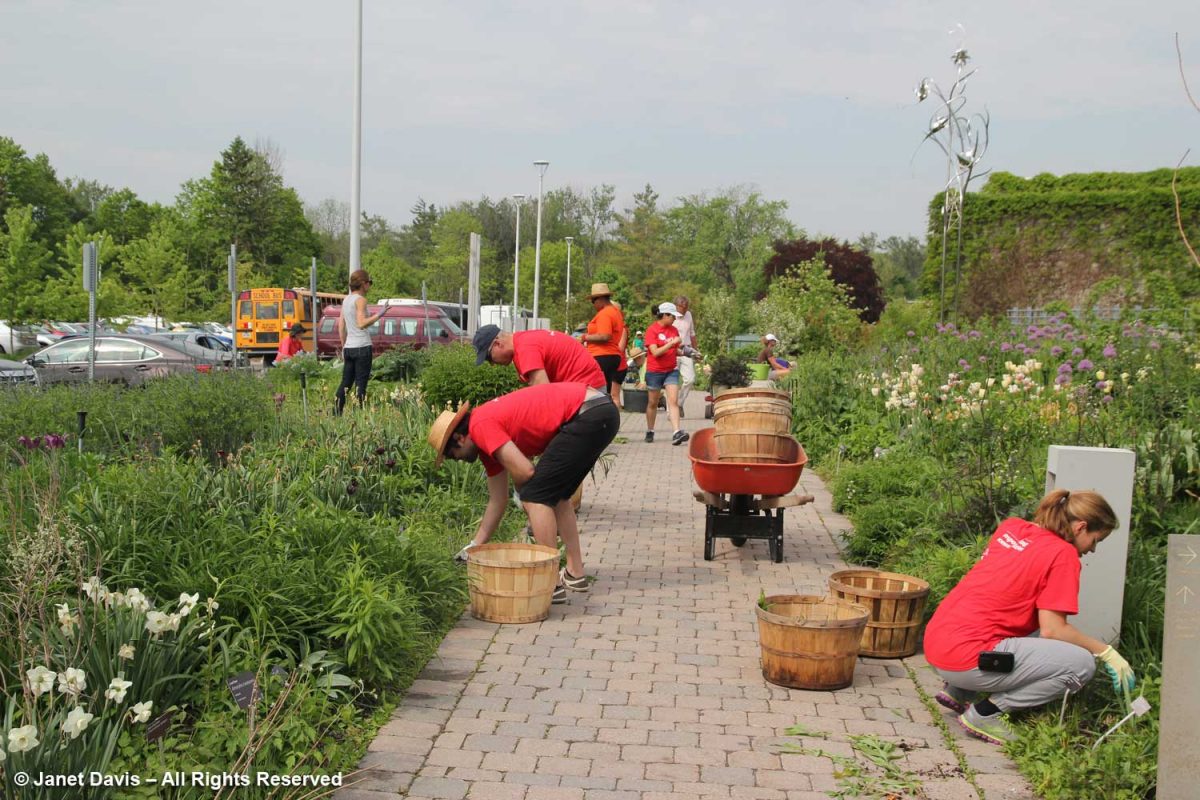
On that note, I leave you with a little musical glimpse at the other population that the Toronto Botanical Garden serves.

I feel your pain. I would be mortified to see that Victorian bedding at the entrance to Kirstenbosch.
We have had our issues here too. An earlier battle and then a newly elected board. Complaints about lack of visible maintenance (staff kept at home in COVID lockdown, now catching up steadily) Recently introduced dual entry prices, cheaper if you have South African ID – which I appreciate when I take my sister. I have been a member with free entry for decades.
It is such a joy to meet and walk at Kirstenbosch – the mountain, always changing flowers, the new ish boomslang walk above the arboretum, outdoor widely spaced restaurant <3
Thank you, Diana. I know board battles are a fact of life in not-for-profit institutions, but it’s vital to keep standards up as much as possible. Victorian bedding does not qualify. I loved being at the top of the Kirstenbosch, and only wish I had time to walk up into the fynbos.
It isn’t just about money. It’s what happens when you have a board full of business people, a CEO (!) who has no botanical gardening experience. They managed, nevertheless, to hire a brilliant and creative Director of Horticulture and then dropped him a year later. When he was there, all during the pandemic, the garden looked creative and brilliant. This is what you get when that creativity is snuffed. I have been a member for 25 years and a donor for most of those years, but I’m sick of seeing the place destroyed by people who have no clue. Considering giving up both my membership and my volunteer work. So terrifically sad!
Please don’t give up on the TBG Carol. It needs people with passion, like you. We cannot fix past missteps, but hopefully the board understands that the membership includes seasoned gardeners who have a deep and long connection to the garden. That relationship should be nurtured, not ignored.
Bravo Janet! You’ve summed it up beautifully, and added to our dismay with your photographs of today. Funny, even my suburban neighbors haven’t planted red and blue salvia this year. The photos of former years illustrate why I used to visit the TBG for garden ideas. I loved Paul Zammit’s lush planter boxes. I realize thus has been a strange couple of seasons for the TBG because of Covid, but that’s no excuse for mis-management and lack of creativity. Please, please,new board members, listen to us serious gardeners who love the TBG and want t see it continue with innovative gardens and good educational programs. And conferences, as in the past. It’s a real shame to see what’s going on now.
Liz, thanks so much for chiming in. As the longtime former editor of Canadian Gardening magazine, you know the potential of the TBG. We need it to be firing on all pistons, not just now but in the expansive future!
The garden can be a true gem in the city. In order to become the world class Horticultural destination that it can be, it requires dedication, vision, and a strong connection; both to the industry now, and where it is headed in the next decade and beyond. I would like nothing more than to return to the gardens and be part of the team that ushers them into the next chapter. Paul Zammit’s hard work and vision is something I have the utmost respect for. His use of plant material, combinations, and pairings is nothing less than inspirational. I was truly honoured to continue the work that he started, only time will tell what the next chapter holds. I am hopeful that the new board will steer the organization to become the world class horticultural destination Toronto so desperately needs. A garden without vision and passion is simply a place with a few plants.
Paul, thank you for your response. You, above everyone, knows how hard it is to run the physical garden, and how much is needed in the way of resources. I’m so sorry about what happened to you and to Paul Zammit. Hopefully the new board will recognize that you need creativity and experience in the chief horticulturist role. All the best.
OMG. That looks like the Civic Garden Center I was horrified to see when I first moved to Toronto from Vancouver, many, many years ago. I wasn’t a gardener then, but I knew that carpet bedding of pelargoniums, salvia and impatiens did NOT make a great garden. Since then, I have become a Master Gardener, TBG member, donor, instructor and volunteer.
Living downtown and constrained by the pandemic, haven’t been up there for more than a year. I was thinking about renting a car and going up for a good walkabout.
What you have shown us is definitely not worth the price of a rental car … and it breaks my heart.
Yes, the organization had been poorly managed and run into the ground financially and needed to be restored to financial health. But it should not have lost its mission in the process.
Such a tragedy.
Yes, Elizabeth. Exactly. It should not have lost its mission. Hopefully things will improve and we will have an expanded garden of which we can be very proud.
Amen! You have written my feelings as well.
Thanks Jessica. Good to see you back here!
Undoubtedly, there are many reasons why the TBG has gone into such steep decline: lack of funding; lack of leadership; tone-deaf leadership; fewer donations; COVID; and other assorted unknown factors. Basically, a tsunami. But it will be important for leadership at the TBG to dig itself out of this deep hole if it wants to halt its spiral into mediocrity and indifference. When visitors leave theTBG unimpressed with its horticultural displays, they will not return. Nor will they recommend the gardens to anyone else. Nor will they be inclined to donate, volunteer, shop at the gift shop or participate in the garden’s programs.
Thank you, Janet, for documenting the current state of affairs. Your startling photo comparisons say it all. I agree that charging admission to the gardens should be considered — politics and past practices be damned. The TBG is a jewel and needs to be treasured and respected.
Thank you Beckie. Yes…. a tsunami, a perfect storm. But the ship is still floating… it just needs to right the course… and the crew needs to stop pretending everything is fine. I hope things improve with the new board.
What a shocker! Toronto bills itself as being an important city, the biggest and best in Canada. And yet it has no botanical garden worth the name. Without knowing the details, it is easy to blame the board, particularly if it is led by someone with no horticultural knowledge or sensibility. Financial difficulties put a terrible strain on an institution but creative leadership finds ways to manage without succumbing to red and blue salvias. I hope this post and the comments that others have made will convince the board to make necessary adjustments.
Thank you Pat. Yes, they are mistakes that should not have been allowed to occur and it may be “best intentions” given the financial difficulties .. but it was all so unnecessary.
What a terrific piece of reporting on the state of the TBG a place we love but…
The AGM was dreadful: a clap hands for us affair without telling us what was really going on. The state of the gardens. Is pathetic certainly in originality (none) and imagination (zero). Good on you for giving this very analytical and reasonable account. thank ou
Thanks Marjorie. I know you put in your time on the TBG board and have its interests at heart. I wish you were there to speak your mind.
Oh Janet, I could write pages about this. It worries me greatly that the expanded TBG still won’t be able to charge admission (BTW, this spring before it fully reopened, the RBG was charging $30 per car to visit the Arboretum during cherry blossom time and the same to see the irises and peonies at Laking Garden). I very much hope that the new partnership agreement with the City includes a realistic–nay, generous–amount of financial support for the personnel, amendments, equipment, plants and seeds and so on that will be needed in order to successfully manage and maintain it.
At least Harry Jongerden was able to secure paid parking, with the fees going to the TBG. I believe that this has been a vital source of funds during the pandemic.
We had no such revenue stream during my tenure. The original–and in my view, flawed and lop-sided–agreement also stipulated a free admission policy and came with plenty of other restrictions, so this meant that every year, our hands were tied yet somehow we needed to magic up more than 90 per cent of our operating funds. There was no cushion–or endowment fund–to fall back on if things got rough, as they did when the City’s parking lot–which took more than seven months to complete–went in, effectively cutting us off from all but the most intrepid members and visitors, who had park elsewhere, then hike over uneven, icy ground to get to the building. Not surprisingly, our shop, rentals and programming (classes and events) revenues plummeted.
I spent a lot of sleepless nights wondering if we’d be able to make payroll and keep going. It was a grim time, and one that I hope will never be repeated to cause the next Executive Director (please drop the inappropriate CEO title) more sleepless nights. The TBG–and Torontonians–deserve better.
Thank you Aldona for your highly informed and experience-driven reply. You and I share the same worries about the TBG and I hope that those who are reading this who have the ability to make recommendations for its ongoing success take your concerns to heart. The garden deserves much better.
Janet, as usual, you have written about the situation at the TBG with your customary skill and talent, qualities that you unstintingly offered every time I asked for photos or an article for Trellis (and there were many, many times!). During the 17 years I was editor of the TBG’s magazine, I cannot recall a time when a writer or photographer refused to contribute their time and talents to the magazine, despite making it clear that I could offer them (limited) fame and certainly not fortune. What compelled them to contribute to the TBG’s magazine was not down to my persuasive powers, but to a commitment to and respect for the Toronto Botanical Garden. We were all part of a community that pulled together to create the best that we could, knowing the restrictions of money that constantly loomed over the TBG. For the past few years, that sense of community seems to have been undervalued and disrespected, and our members accused of resisting change (ibid the Globe article). Well, if change has brought about the Victorian era plantings that scream of the past, then yer darn’d right we’re resistant to change. Although in contemporary parlance, “change” often denotes progress, the word actually means an “act or an instance of making or becoming different”. With the help and guidance of a renewed board of directors, I have every hope that the incoming director of horticulture and executive director can help the TBG make a difference—one that grows from their experience within the broad horticultural community and that springs from a vision for the future that will bring about enlightened change for the organization that we love, and to our city.
Thank you Lorraine for your comment. It has always been my pleasure to contribute to the Trellis and to the Botanical Garden in general. I know we all share a passion for what the TBG has done in its relative youth and have high hopes for its expanded future. The leadership could not be more wrong about concerned members resisting change. We were resisting destructive chaos. But the actual “botanical garden” part of the institution has often been treated like a lesser component. That has to change. And the new Executive Director and board need to work hard on improving staff morale so everyone is working together for the good of the organization.
It is a bit intimidating to write a comment after so many heavy weights have spoken on this matter. As a member without a window into the workings of TBG your post and Globe article have been very informative.
I have been a member of TBG for more than 25 years. As a member who lives in Mississauga and travels to TBG by transit, it has always been a destination of inspiration, education and like minded folk. It also felt like a home away from home with a great library. On my last visit a couple of years ago I was very disappointed to see the state of the gardens, and the lack of courses being offered. Then, came all the changes in staff, I had a feeling something was wrong. I could not imagine it ran so deep. Harry had so much vision and energy, it makes me sad he will not be seeing his vision actualized. His legacy project.
It is a difficult situation when the garden relies so much on volunteers. To expect them to give their time knowing the people at the top are so overpaid. It would make me rethink giving my time.
I have been looking forward to the expansion of the garden for years. Now it worries me that it will not be a place of vision.
Toronto is starving for a revitalized inspirational botanical garden. We deserve it.
Why does Montreal have a world class one, and yet we have an embarrassment?
I will keep hoping my dream garden will be created before I retire and move out of the city in a few years.
Thank you Lori. Your heartfelt reply touches on many of the concerns others have as well.
Why, indeed, is Montreal’s Jardin Botanique one of that city’s major tourist attractions and showered with millions of dollars by the city of Montreal? Yes, it’s much bigger but there is an understanding that gardens and nature are inherently good for Montrealers. It’s not downtown but way up at the Pie-Neuf subway stop. And it is in the top 3 botanical gardens in North America.
In contrast, many Toronto politicians (excluding our own hard-working councillor) seem not to understand what their peers in Chicago, New York, Vancouver and Montreal do. Botanical gardens are worth the civic investment. Not pocket change. A proper investment.
As for Harry Jongerden, he has taken a seat on the board and will definitely see his expanded garden come to fruition.
I have also been, and will continue to be, a member, a donor, and a volunteer Master Gardener at the TBG for many years. I’ve also been a fan, and have written many words and shared many pictures about it on Toronto Gardens.
When in 2015, our volunteer team brought 75 garden bloggers from Canada, the U.S. and UK to Toronto for the Garden Bloggers Fling – the first and so far only international city to host what pre-Covid was an annual event – showing it off as a garden city, our culminating event at the Toronto Botanical Garden was a highlight. This link from our four-day event shows the kind of international coverage and attention that gardens can get IF the gardens are worth writing about: Here’s what they wrote about GBFling15
Covid has been a hurdle, for sure; but, along with the ambitious plans for expansion, it has only shone a light on ongoing problems. Hoping the new Board applies some solid creative thinking about how to fund our once and future, and once again creative, botanical garden.
Yes, Helen. What a wonderful event you organized with the TBG at its very June best as the centrepiece. I cannot imagine what visitors would think now. Actually… yes I can.
I agree. Let us hope that the new board grasps the importance of the public face the garden puts forth.
But it’s not just boards and executives who have made negative decisions. We should not have to be in a position of going cap in hand to the city when adversity hits. Someone at city hall needs to read up on Chicago’s former mayor Richard M. Daley and how he pushed and fought for his city’s Latin motto, “Urbs in Horto… city in a garden”. We too have the ability to have our city be a garden… and we don’t need rail decks to do it. It is right here at Leslie and Lawrence in the geographic centre of the GTA.
Very true, Janet!
Living in Chicago and seeing the massive increase in use of downtown lakefront Park and adjacent Art Institute in the years since the installation of the Oudolf Garden which anchors Millennium Park, it is difficult to understand a world class city neglecting their established and formerly enticing, exciting garden.
Thanks Donna. Yes, the Oudolf entry border gave the TBG star appeal but gardens aren’t static. This one needs more civic support and hopefully that will be recognized.
Janet, your photos show such a sad decline in the quality of the TBG’S plantings. So many years of creative work have now been swept away. In my many years of writing garden columns, I’ve always recommended the TBG as a source of knowledge and inspiration for new gardeners, but I can’t, in good conscience, do that anymore. Frankly, I’ve seen dozens of home gardens that surpass the amateur beds at the TBG, so why even bother going there?
As for City Councillors, their lack of interest may reflect Torontonians’ lack of interest and involvement in the garden. I was astonished to hear, at the last AGM, that the TBG has only 5,000 members or thereabouts. Garden blogs like yours and Facebook garden groups have more followers than that! I hope at some point, TBG leadership will realize that it must make a real effort to be Toronto’s garden, so that the people and government of Toronto can more fully support it.
Thanks, Mary Fran. I believe the membership is well south of 5,000 now, which is unfortunate. There needs to be an active recruiting drive and, along with that, educational programs that reach all of Toronto’s diverse communities. As for city councillors, perhaps a tour of the garden would be in order with plans for the future. Sadly, with the lack of creativity at present, the current garden doesn’t show very well. Hopefully things will change.
it is well south of 3000 member now